How to Plan an Amazing Seattle to San Francisco Road Trip
If you’ve spent any time at all in our little corner of the internet, you know that we’re big fans of both the Pacific Northwest AND Northern California, the two places we’ve called home together.
The road trip we’re about to talk about – the drive between Seattle and San Francisco – takes you through some of our absolute favorite places on earth, and showcases much of the natural beauty that makes the west coast of the USA extremely special.
We basically spent a full two months on this route a few summers ago, after we quit our corporate jobs (in February of 2020…whoops) and lived in a converted Honda Odyssey for the better part of two years, and it was every bit as memorable, beautiful, and amazing as you might imagine.
Since then, we regularly drive it because our families are located in San Francisco and Seattle, respectively. And we live in Portland, Oregon now, so many of the stops on this itinerary are basically in our backyard.
There are a nearly unlimited number of route combinations you could take to get from San Francisco to Seattle, but which is the best?
Well, that depends on a bunch of different factors, like what time of year it is, how much time you have, whether or not you’re looking to do some hiking, if you’re a beach or mountain person, and too many others to list.
In this guide to planning your Seattle to San Francisco road trip, we’ll give you the best stops to make along the drive from San Francisco to Seattle, and do our best to present you with itinerary options for the various factors we mentioned above (namely time of year and amount of time you have, in this case).
Oh, yeah, we should probably mention that we’ve done some version of this road trip at least three or four times in the past couple of years, since Alysha’s family lives in the Bay Area, and Matt’s lives in Seattle (and we now live in Portland, Oregon).
We’ve driven the coastal route, the central route, and the “drive-it-all-in-one-shot” route (which we definitely don’t recommend at all).
The point is that we have plenty of personal experience to draw from to help you plan an amazing road trip from San Francisco to Seattle.
In this guide, we’ll give you our perspective on the best possible route, and cover the practical information to help you actually plan your road trip.
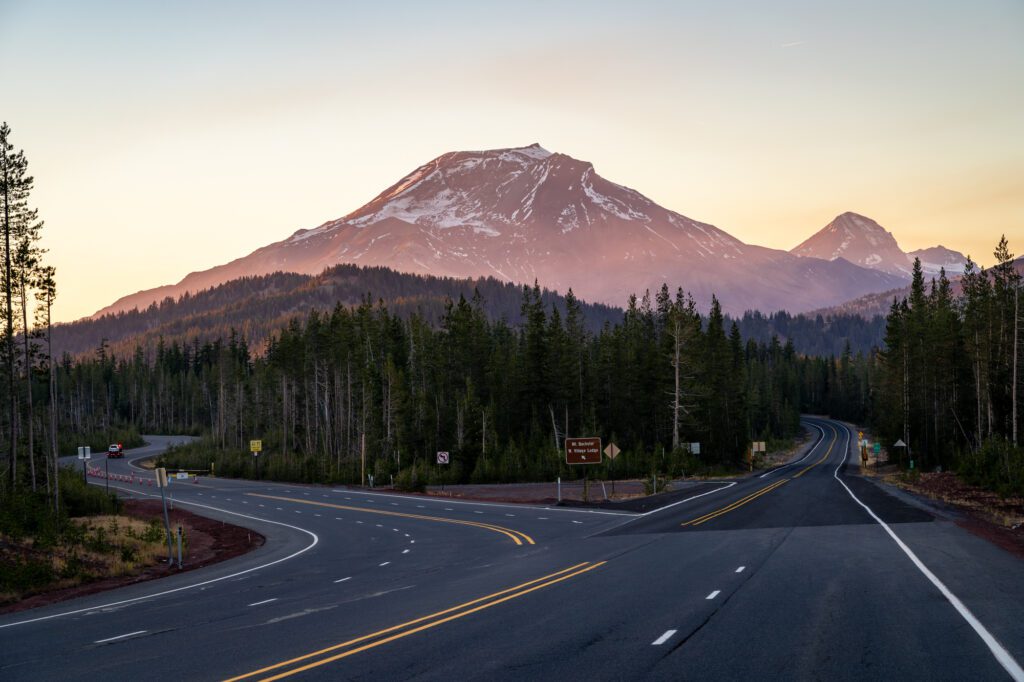
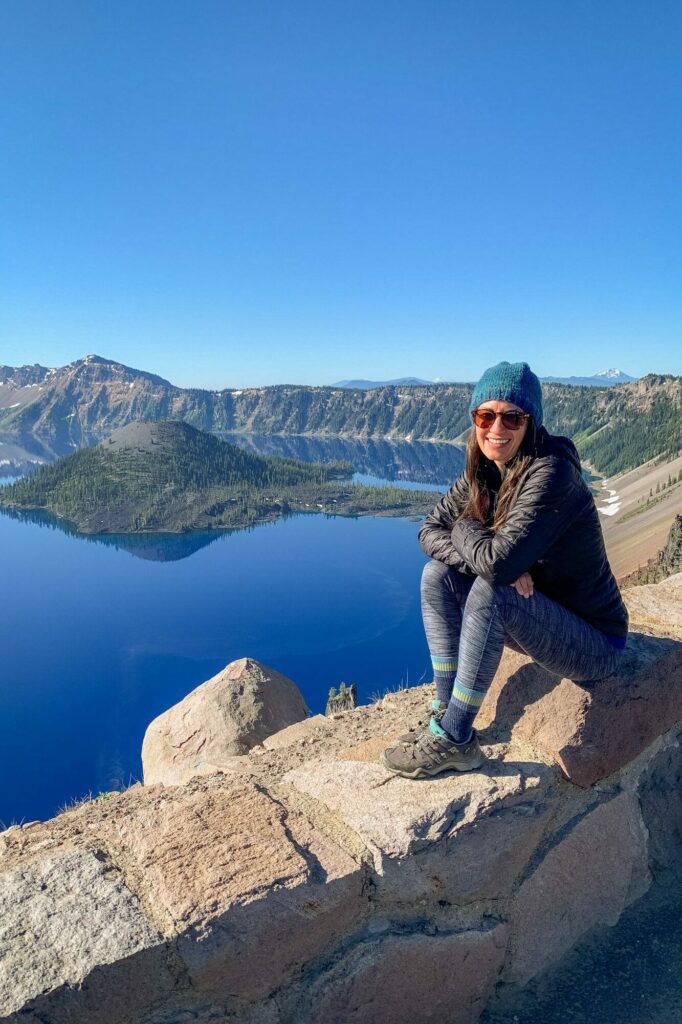
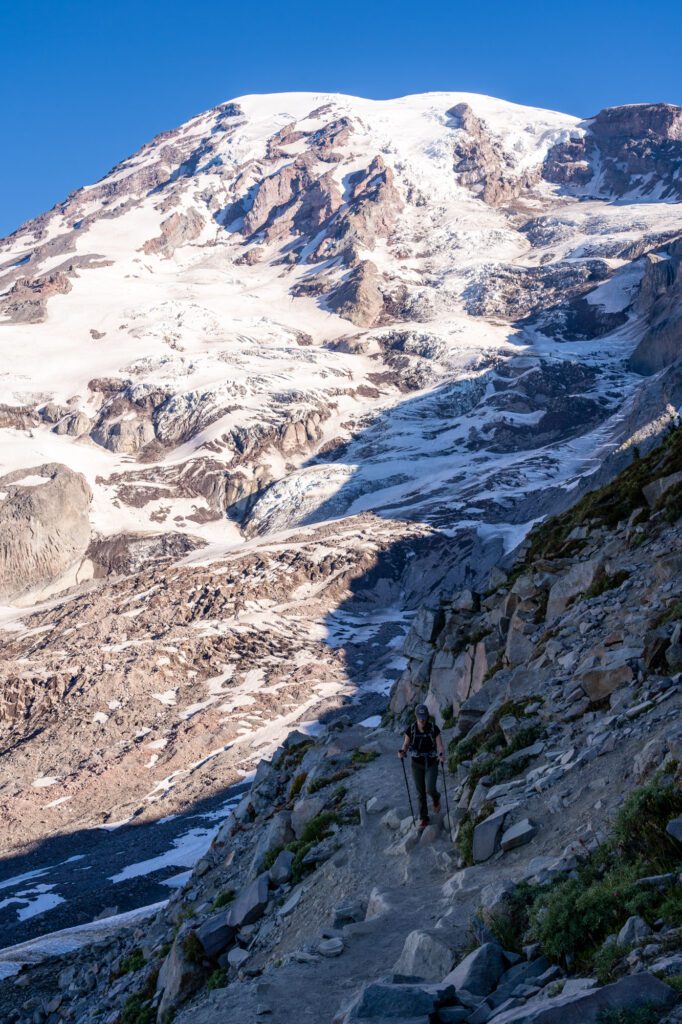
Disclaimer: Some of the links in this post, like hotel links, are affiliate links, meaning at no additional cost to you, we make a little bit of money if you click through and book. That being said, we would never recommend something to you that we don’t stand behind 100%.
Where to Fly In and Out of
Usually, this section is “where to start and end your road trip” but, given that this guide is about driving between two specific cities, I feel like that’s pretty self explanatory here.
Instead, let’s talk about what airports to fly in and out of if you’re planning on flying to the west coast.
One note: If you’re doing this road trip in the summer or fall, we’d consider renting a campervan from Escape (who have locations in both Seattle and San Francisco) for a fun way to experience the Pacific Northwest and Northern California. We first did this road trip in our Honda Odyssey, and fell in love with short term campervan living.
Flying Into Seattle
This one is far less complicated. There’s only really one major airport in the Seattle area – Seattle-Tacoma International Airport (SEA). It’s about 30 minutes south of the core of Seattle, but it’s well-connected to the city.
There’s a second, much smaller airport – Paine Field (PAE) – just north of Seattle, but the convenience of flying out of a small airport (and time saved going through security) is offset by the fact that it has very, very few flights available.
Flying Out of San Francisco
Flying into San Francisco can be a bit of a nightmare thanks to weather delays caused by the infamous fog that flows in and out of the city in the morning and afternoon. We lived in San Francisco for almost a decade, and experienced those delays firsthand.
You have two airport options in the San Francisco area.
First is San Francisco International Airport (SFO) which is the bigger airport with more direct flight options. It’s also the most convenient airport for getting into San Francisco itself. However, it’s also the airport that is most famous for delays.
The second airport option in the Bay Area is Oakland International Airport (OAK), which is across the Bay Bridge in Oakland, California. It’s a smaller airport with fewer flight options, it’s a little harder to get into San Francisco, but it isn’t subject to the fog, and therefore usually has fewer weather delays.
DO NOT FLY INTO SAN JOSE. It’s over an hour south of San Francisco, sometimes more with the ugly Silicon Valley traffic that clogs up the freeways there.
How Many Days to Spend on This Road Trip?
You can totally make it between Seattle and San Francisco in one day.
It’ll take 13 hours, and it’s going to be miserable.
Trust me, I’ve done it (Matt here!).
Twice.
In the past few years.
Instead, we suggest spending AT LEAST 7-10 days to do the drive. The guide below is written with a two week trip in mind.
This route has a total of 24 hours of driving – split up between 10-14 days when you follow our recommendations below.
That could be more time than you have. If that’s a few too many days, then we recommend heading down the I-5 corridor through Oregon instead, skipping Bend and Crater Lake, which are further inland.
You can choose from the stops below based on how much time you have to spend – think of it as a “choose your own adventure” sort of thing (used to LOVE those Goosebumps books!).
Except the authors have strong perspectives on what adventures you should choose.
- With 3-5 days, you’ll be a bit pressed for time, and you won’t be able to deviate from the direct route straight up I-5 as much. Still, there are some worthwhile stops to make along the way, which we’ll cover in the alternate routes section below.
- 7-10 days will give you more time to explore along the way, both the beautiful landscapes at places like Crater Lake and Mount Rainier, and amazing cities like Bend, Portland, and Mendocino.
- 14+ days would be best, but we also know that you might not have that kind of vacation time to burn.
However much time you have, we’ll do our best to give you the information you need to make the most of it.
The Best Route for Your Road Trip
Before we get into the details of where to stop and what to do and see, let’s zoom out and talk about what route to take.
Believe us, there are plenty of options, and we want to help you make the best choice for your interests.
The fastest and most direct route is to hop on I-5 south in Seattle and take it alllll the way down to San Francisco.
It takes about 13 hours, and I’ve personally driven it countless times, including several times where I drove the entire thing in one day. Which I do not recommend.
It’s also the least interesting route, passing through hours and hours of farmland in Northern California.
If you have more than a few days (probably only realistic with 7+), we’d recommend making some detours from that direct route to enjoy the unique landscapes and staggering natural beauty that Northern California and the Pacific Northwest have to offer.
Here’s the route we’d take if you have 7 or more days, which takes in the Cascades, Crater Lake, and the Northern California coast.
An Alternate Route for Winter / Spring Road Trips
In the winter and spring (even into late June, some years), the central route through Oregon and the stop at Mount Rainier will be either inaccessible, or not worth the effort because things will be closed and covered in a deep layer of snow.
If you’re planning a winter/spring road trip, we’d hit the coastal route all the way. In fact, we did this exact road trip each of the past two winters, and while it can be a little stormy at times, the scenery is incredible.
Lucky for you, we have a few guides you can put together to form an incredible coastal road trip.
Start with our Olympic National Park itinerary, roll into our Oregon Coast road trip, and finish with our Northern California road trip.
This route is going to be best with 7+ days because the driving is a little slower than the less windy, more straightforward highways on the main route below.
16 Great Stops to Make on Your Seattle to San Francisco Road Trip
Now, onto the main attraction. We’re going to give you our top stops to make on your drive that we like and think are worth your time.
First, we’ll give you the stops that are along the route we’ve mentioned above.
Some stops are bigger stops that deserve the better part of a day, some are smaller stops that might take a few hours. We’ll leave it up to you to decide.
Then, we’ll give you a couple of changes that you can make in the winter and spring to avoid the snowy mountain passes and park closures, and explore the coast instead.
Mount Rainier National Park
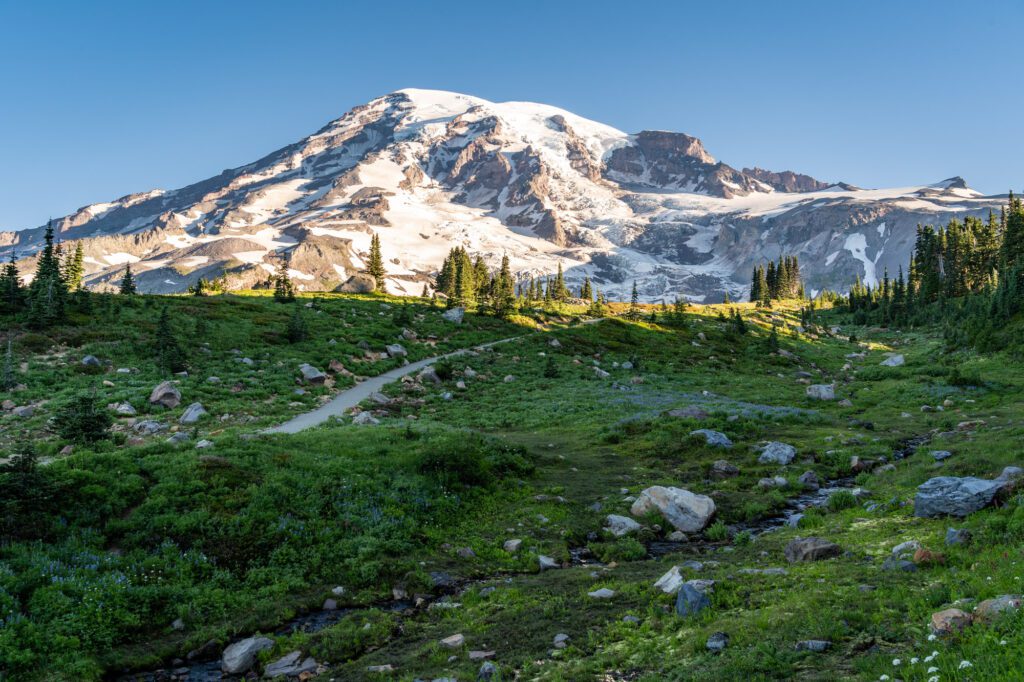
Drive time from Seattle: 2 hours 30 minutes / 110 miles
Mount Rainier National Park is the crown jewel of the Pacific Northwest. In most of Western Washington, the definition of a “good day” usually involves whether the Mountain is visible or not. It is called Tahoma (or Tacoma) in the Salish language, but the name “Rainier” is so named after a friend of a British officer in the Royal Navy, which is pretty classic.
Mount Rainier, the tallest peak in the Cascades that range from Washington down through Oregon, is an awe-inspiring place to visit.
Everything from the abundance of wildflowers in the early summer to the lenticular cloud that swirls over the peak, building in strength throughout the day, is spectacular.
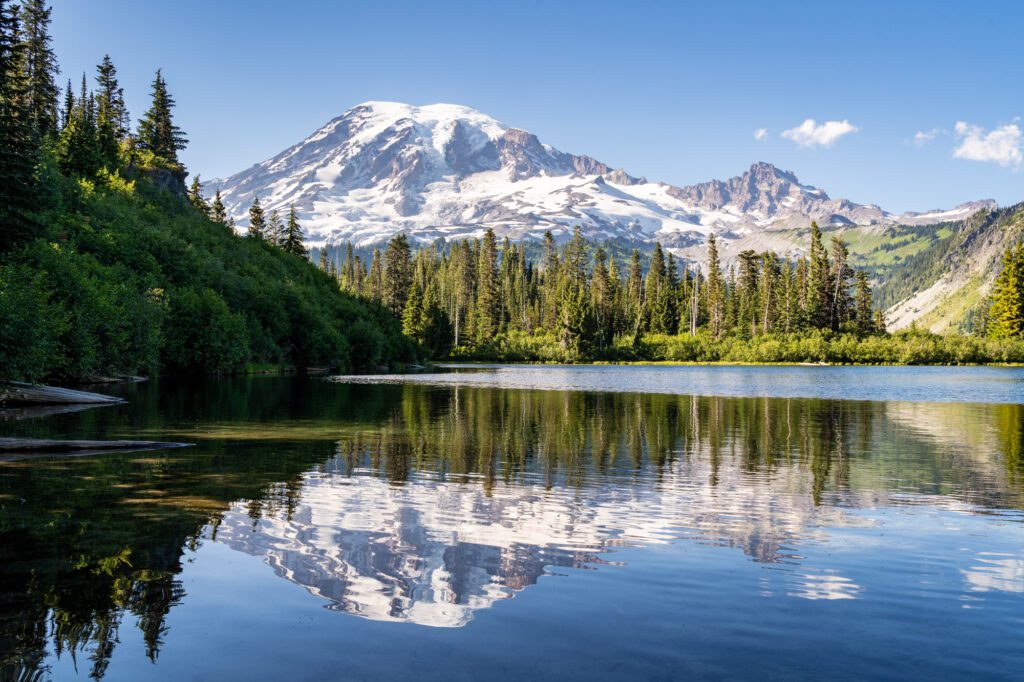
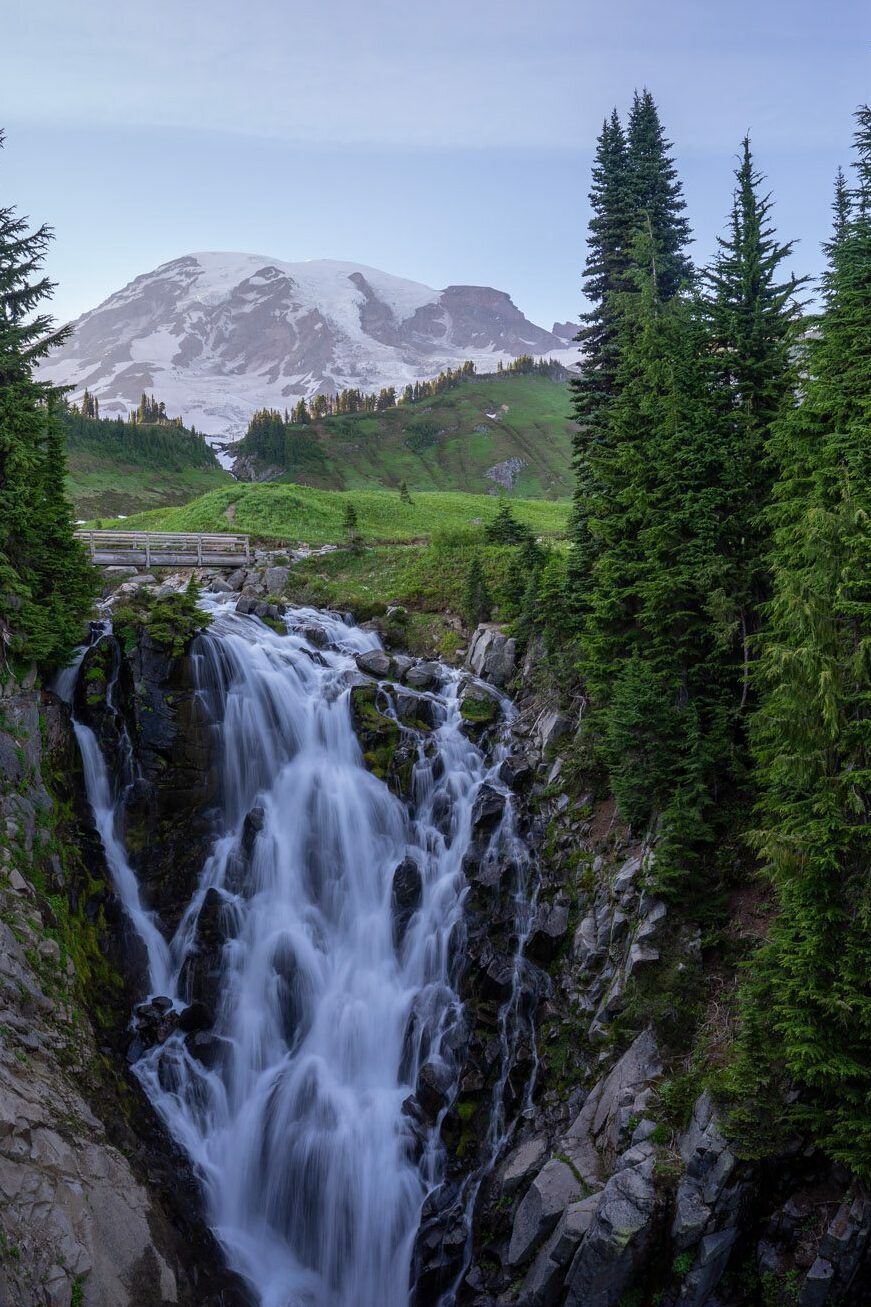
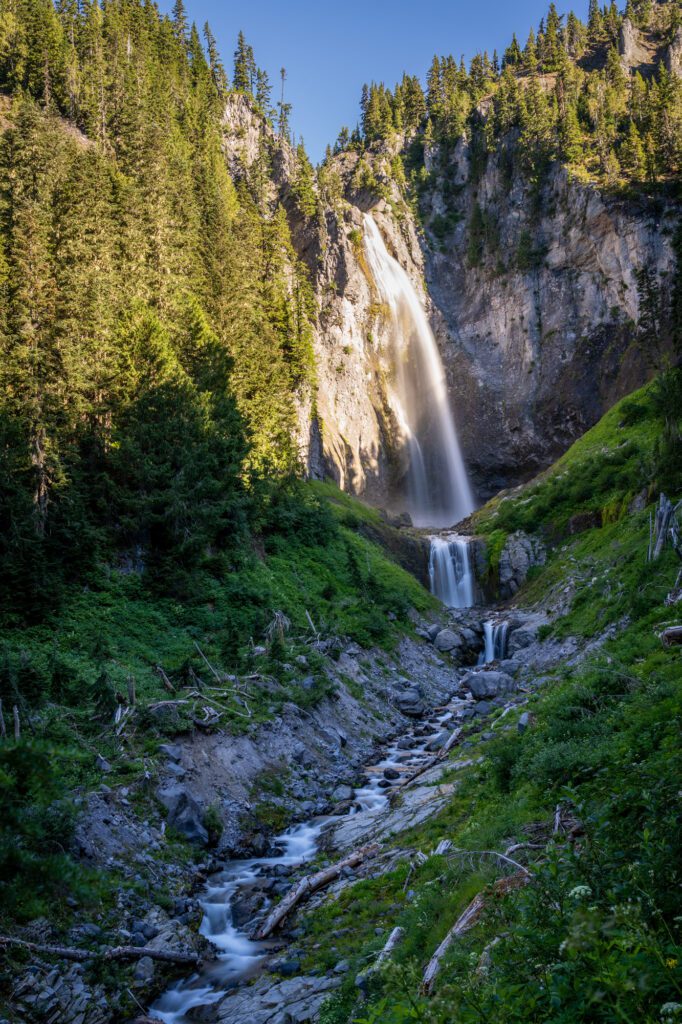
We can’t get enough of Mount Rainier National Park, and would encourage you to make an effort to visit on your drive.
There are five distinct areas of the park, but if you’re coming from the I-5 corridor, the most convenient place to explore is going to be Paradise, which is on the south side of the Mountain.
From here, you’ll get a taste of all the things that make this area special. Countless waterfalls, alpine lakes, and increasingly impressive views of Rainier around every corner.
Of course, the other areas are well worth visiting too, but they’re harder to access from the I-5 corridor.
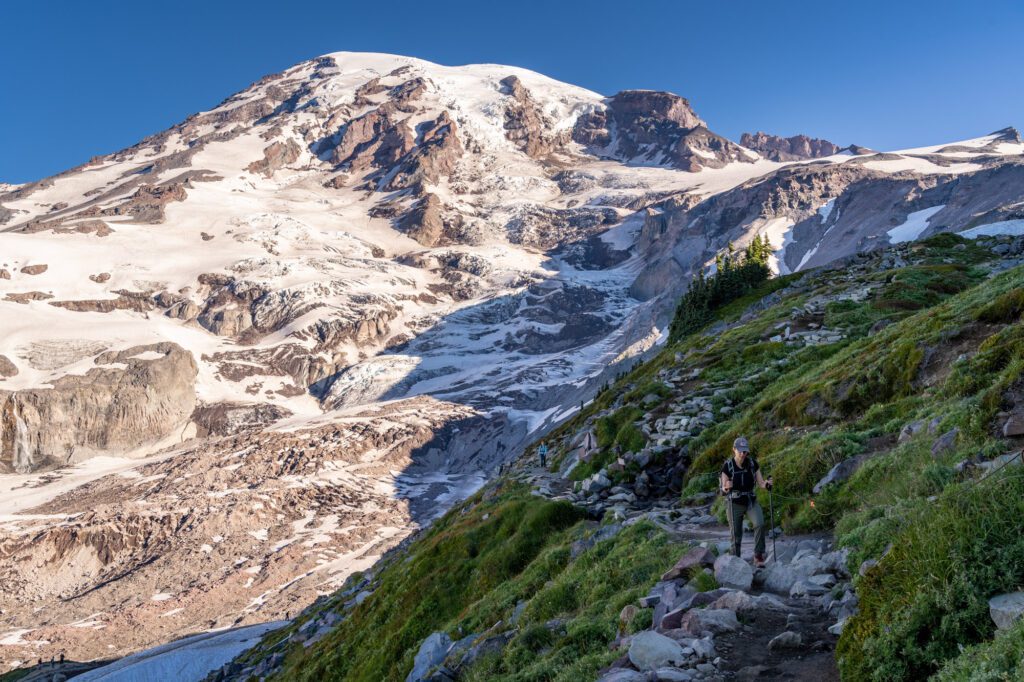
Here are the things we think you shouldn’t miss in Paradise, which to us is an accurate name for this slice of natural beauty.
- Hike the incredible Skyline Trail: This hike (pictured above) is in the top three of our list of the best hikes in Washington State. From start to finish, the views of Mount Rainier are nothing short of spectacular, and they get better the higher you climb towards the 14,000 foot peak. The Skyline Trail Loop, which we’d do counter-clockwise, starts from the parking lot at the Henry M. Jackson Visitor Center, and immediately takes you past Myrtle Falls, a gorgeous waterfall, and through a meadow bursting with wildflowers with Rainier looming over it. You’ll climb to Panorama Point, where you’ll have an unparalleled view of Rainier and the surrounding Tatoosh Range and Mount Adams. It’s a great hike. The shorter, easier Nisqually Vista Trail or Bench and Snow Lakes Trail would be good alternatives if you’re not confident in your ability to do the Skyline Trail.
- Visit Reflection Lakes: This is a great spot with a picture-perfect reflection of Mount Rainier in the water of the lake. It’s very popular with humans and mosquitoes alike, especially in the summer. Stop here for a spectacular sunrise or sunset.
- Admire the waterfalls: This part of the park is full of gorgeous waterfalls. The easiest to access are Narada and Christine, which are basically just off the road. Myrtle Falls – our favorite of the bunch – is a half mile hike from the main parking lot along a paved trail, and Comet Falls involves a four mile hike.
You can read our other guides to Mount Rainier’s best hikes and the best things to do in Mount Rainier National Park to help you venture out to the other parts of the park.
Mount St. Helens
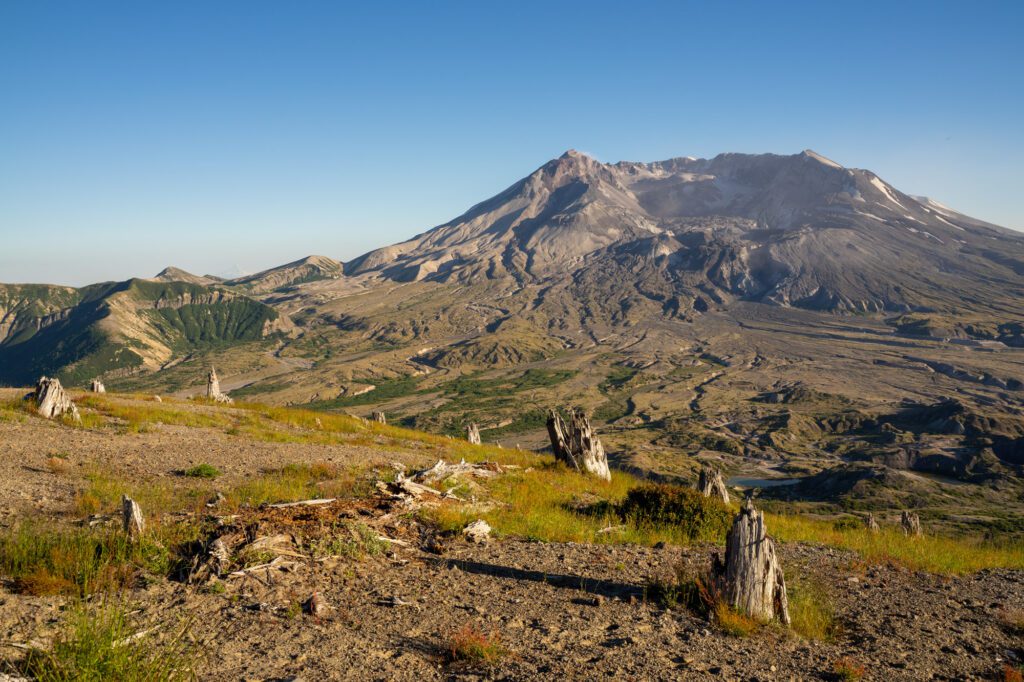
Drive time from Mount Rainier: 3 hours / 130 miles (though it’s shorter if you’re coming from I-5)
Mount St. Helens is just a couple of hours north of Portland, but most people skip it in favor of the more famous mountain just north, Mount Rainier.
And to be honest, we get it. If you’ve only got a couple of days in the area, it’s better spent around Rainier. And the fact that both St. Helens and Rainier are a solid hour from the I-5 corridor means that you’re probably picking one or the other.
But with more time, we’d give Mount St. Helens a look. Especially if you want to avoid the crowds that descend on Rainier in the summertime.
The western side of the mountain is the easiest to access from the I-5 Corridor, though the less-visited eastern side is gorgeous. If you find yourself over there, definitely do the hike up to Norway Pass – one of our favorite hikes of all time.
The Johnston Ridge Observatory is your destination on the western side.
It’s about an hour inland from I-5 along a steep, climbing road that passes Coldwater Lake before you emerge onto a ridge with spectacular views of the volcano that wrought so much destruction on the surrounding landscape 40 years ago.
Even 40 years later, you’ll be surrounded by evidence of the destruction that St. Helens’ 1980 eruption brought upon southern Washington and northern Oregon. Logs from downed trees are scattered on all of the hills surrounding the volcano.
While you’re there, we’d make sure to hike at least a portion of the hike out to Harry’s Ridge, which takes you along the ridge and gives you an incredible view of Mount St. Helens.
Check out the Johnston Ridge Observatory, and make a stop at Coldwater Lake for lunch and a short stroll along the lakefront on the way back down towards the freeway.
You only need about half a day to explore the area on the western side of St. Helens, though with the driving it turns into the better part of a full day.
Portland, Oregon
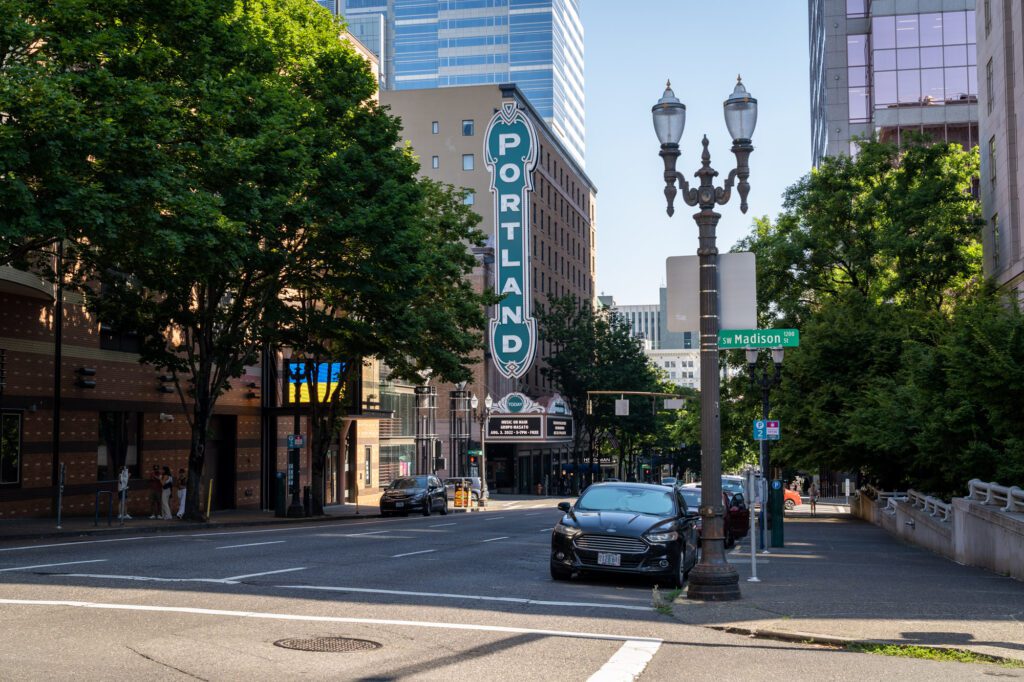
Drive time from Mount St. Helens: 2 hours 20 minutes / 110 miles
Ah, Portland! We love Portland, which is why we decided to relocate here a few years ago after nearly a decade of talking about it.
Portland takes the things we love about living in Seattle and San Francisco and makes them better because the cost of living is (slightly) lower, which means there is more opportunity for innovation from local artists, chefs, and other small businesses that just doesn’t exist in places where it costs a million dollars to do anything.
Specifically, Portland has unrivaled access to nature and green spaces in the city center, a thriving food and drink scene with a surprisingly diverse set of offerings (given the fact that Portland is NOT diverse), and access to both the ocean and the mountains within 90 minutes or so.
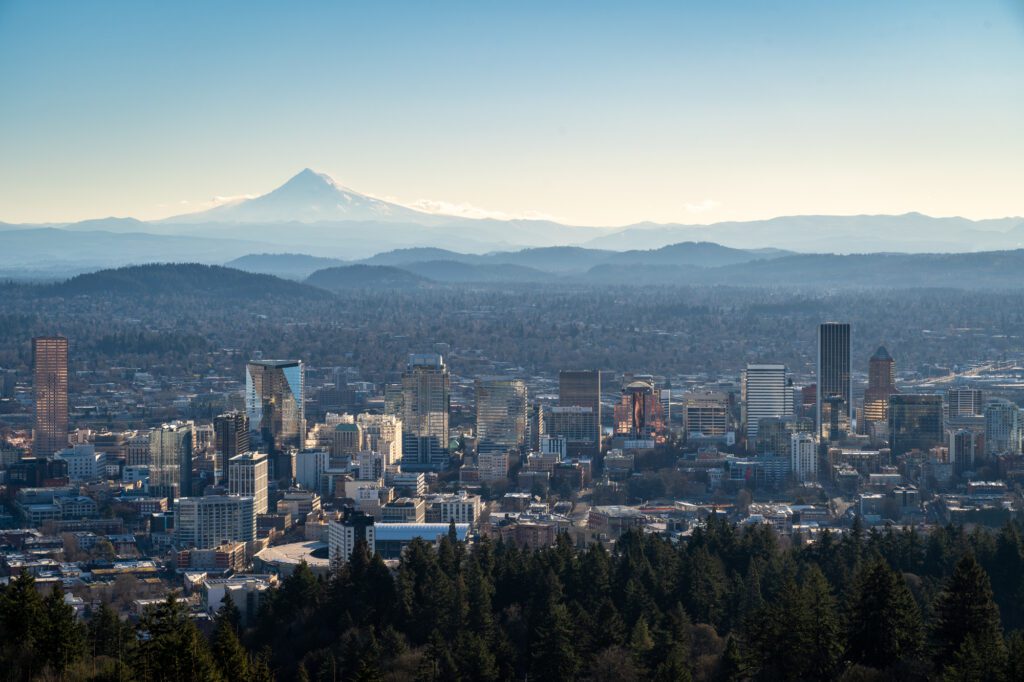
Now, if you’re on a road trip, chances are you’re looking to spend most of your time outside of major cities. Which we totally get.
However, we’d strongly recommend a stop in Portland for a meal, at the very least. Specifically, a meal at a food truck!
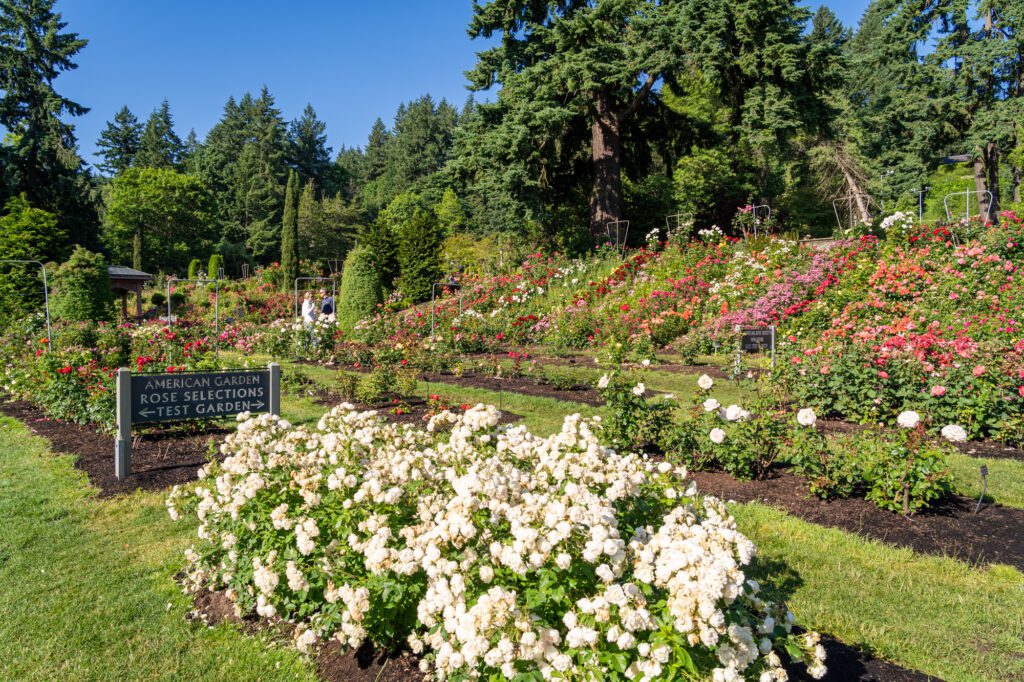
Here are a few things to do that we think are worth your time, even if it’s limited. For more, definitely read our guide to the best things to do in Portland.
- Powell’s Books: The biggest independent bookstore in the world! We take all visitors here, and regularly visit ourselves. It’s worth going to their flagship in downtown Portland, which is a massive multi-story building full of books from all genres.
- Eat at a Food Cart Pod: Portland is famous for its food cart pods, which are somewhat unique and offer a really important part of Portland’s food scene: a lower cost way to try a concept without investing in a full restaurant. Take a look at many of Portland’s hottest restaurants and you’ll find that they actually started as a food truck, slowly expanding their empire into brick and mortar. It’s cool, and it’s part of what makes Portland such an interesting food city. Our favorite pods in the city are the Prost! pod near Mississippi Avenue in NE Portland (we used to live nearby) and Hawthorne Asylum in the Central Eastside.
- The International Rose Test Garden: Stop and smell a massive amount of breathtaking roses at the International Rose Test Garden, which has 10,000 buds that bloom from June to October, roughly. Great views of Portland and Mt. Hood (on a clear day) too!
- Eat Some Doughnuts: For doughnuts, which are a must-try in Portland, a city full of artisanal donut shops, enjoy delicious donuts at Pips Original (sadly not gluten-free, but they offer chai flights, need we say more?), Blue Star (also not gluten-free), or Petunia’s (100% gluten-free!). You’ll notice that we skipped Voodoo, the most famous doughnut spot in Portland, which has average doughnuts, but does deliver on the Portland vibe (though they have a location at Disney World these days). If you MUST go to Voodoo, go to the one on the east side of the river (here on Google Maps), which is a much more pleasant experience.
The Columbia River Gorge
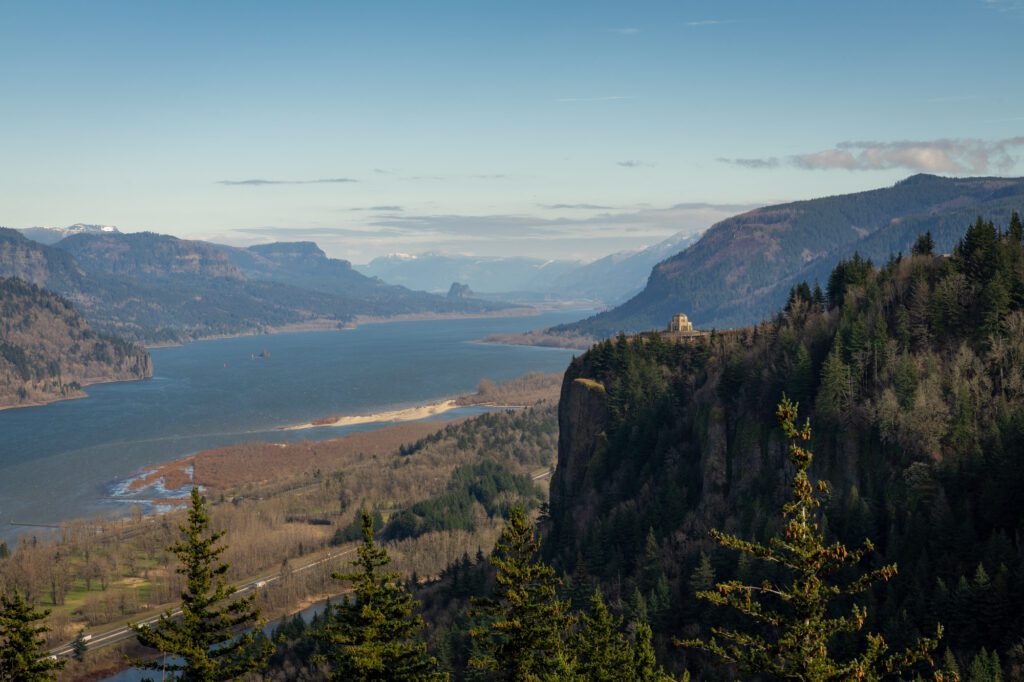
We’re not including drive time here, because it starts just after you leave Portland, and ends in Hood River.
In this section, we’re going to give you a route between Hood River and Portland that has you enjoying our favorite stops in the Columbia River Gorge.
The drive between Hood River and Portland is about an hour, but with all the stops to make along the way, it will take you at least a half day to complete. You’ll see three waterfalls along the way, which is what the Gorge is arguably most famous for.
The Vista House and Women’s Forum Viewpoint: Both along the Historic Columbia River Highway, these are two of the best views of the Gorge you’ll find anywhere. The Vista House is here, and just a bit further up the road, the Women’s Forum Viewpoint is here.
Latourell Falls: A quick and easy waterfall hike that takes you up to the upper falls, then loops down around, crossing under the highway to bring you to the base of the more spectacular lower falls. Don’t settle for the view from the parking lot, it’s worth doing the short hike! More trail information here.
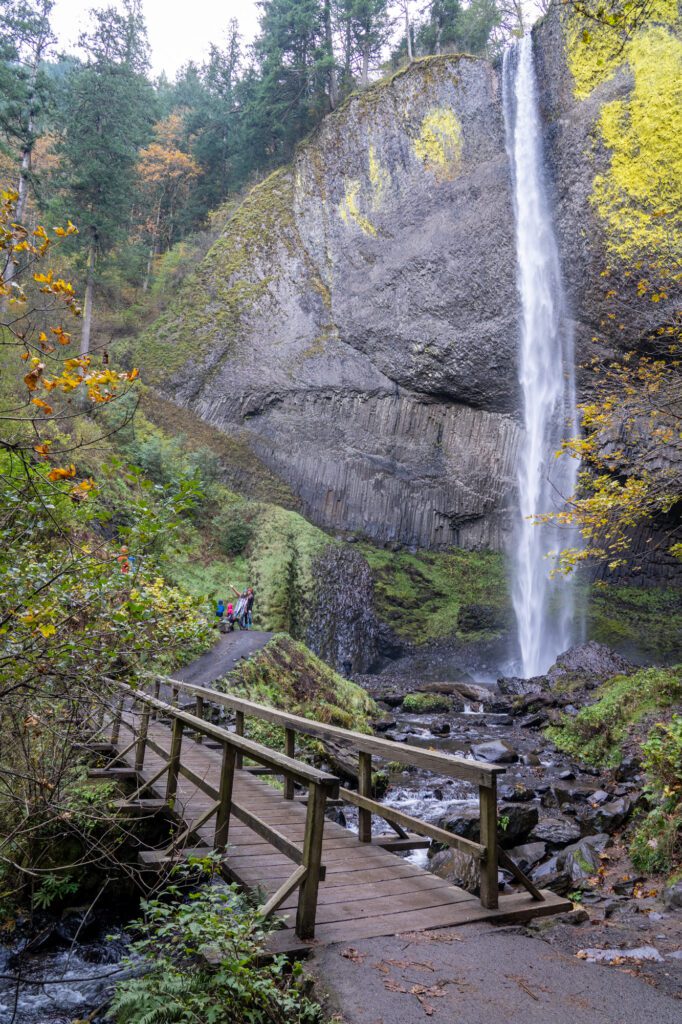
Multnomah Falls: While this is the most famous waterfall in Oregon, it’s not our favorite. That’s not to say that it’s not spectacular – it absolutely is – but it’s SO CROWDED. You should get out and see the waterfall, but there are better waterfall hikes nearby to tackle instead. If you’re looking for a less visited waterfall, head to Dry Creek Falls, which intersects with the Pacific Crest Trail and ends at a nice waterfall with far fewer visitors.
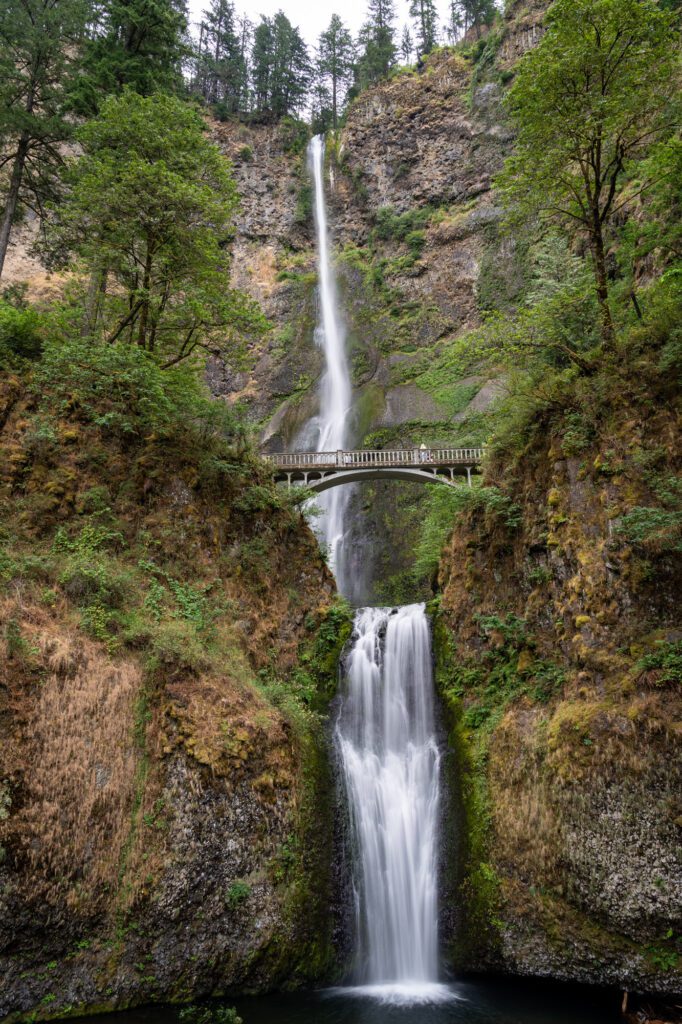
Horsetail and Ponytail Falls: A little bit further down the Historic Columbia River Highway are two of our favorite waterfalls in the Gorge – Horsetail and Ponytail. Horsetail is visible from the parking lot, and you can do a quick half mile hike up to Ponytail, where you can walk back behind the falls, which is cool.
Hood River
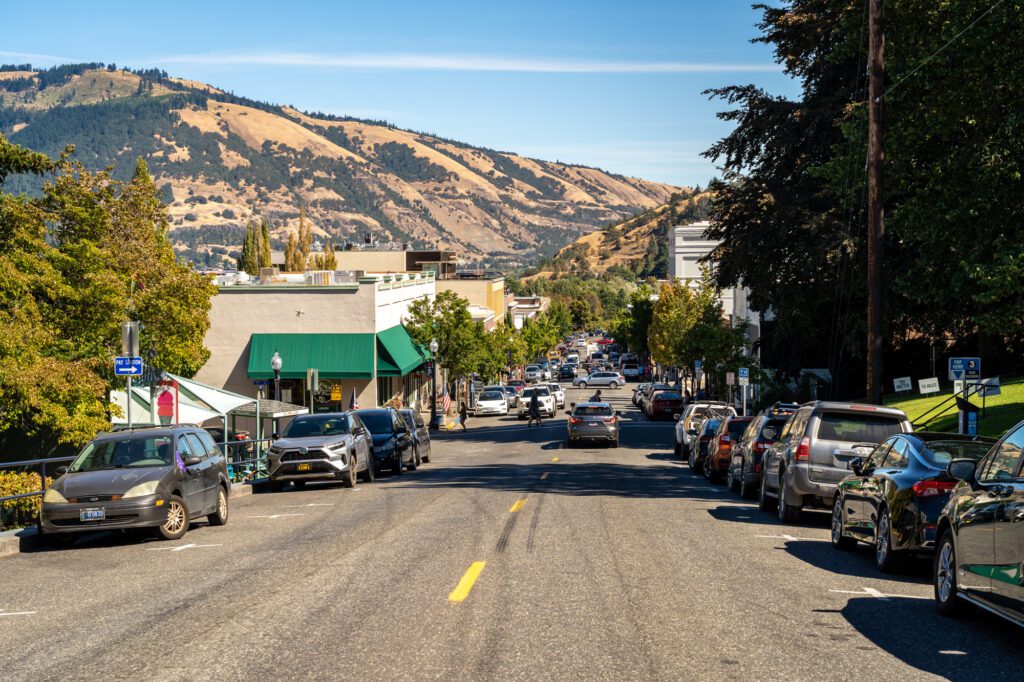
Drive time from Portland: 1 hour / 63 miles
Hood River is a charming town in the Columbia River Gorge that generally marks the point where the landscape turns from the temperate, wetter climate of western Oregon to the drier, warmer climate of the central and eastern parts of the state.
The town is known for windsurfing thanks to its position right on the Columbia River Gorge. The wind whips through the gorge and creates an ideal pocket for windsurfers.
As you drive towards Hood River from Portland, you’re likely to see a bunch of windsurfers on the water on days where the conditions are right.
It sits on the northern edge of one of the most fertile areas in all of Oregon. Cherries, apples, pears, and grapes all grow here with great success, and it’s a perfect area to sample local produce.
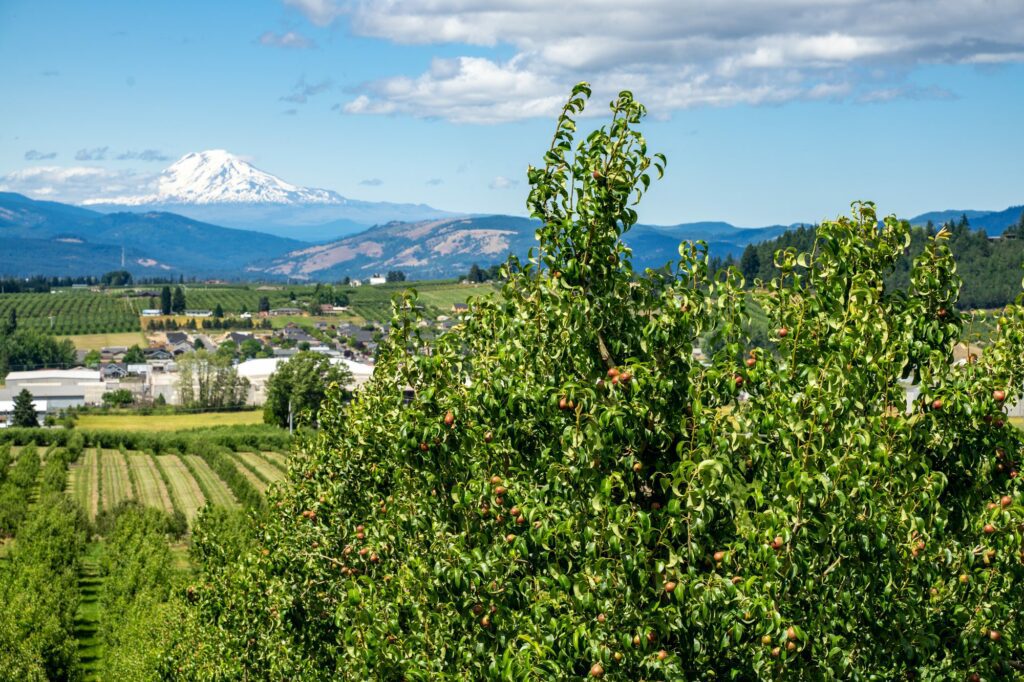
Here are some things not to miss in Hood River – we’re not including activities in the Columbia River Gorge here, because we have a whole section on that above.
- Drive the Fruit Loop: Speaking of amazing produce, the Hood River Fruit Loop is just south of town, and you’ll drive right through it as you’re approaching from Bend. This is where the apple trees go as far as the eye can see, backed by jaw-dropping views of Mount Adams, Mount Hood, and Mount St. Helens. Stop by Hood River Lavender during the summer to see blooms of purple lavender in the foreground, with Mount Hood in the background. Draper Girls Country Farm is the place to go for farm-fresh (and u-pick) produce, including cherries in the summertime. And the Gorge White House is a nice stop for lunch, wine, or cider in a gorgeous setting.
- Drink at a brewery in town: There are a couple of famous breweries in Hood River that were among the first craft breweries in Oregon. Full Sail has a taproom right in downtown Hood River, and Double Mountain Brewery is just a few blocks away, making it easy for you to hit both and decide which is your favorite.
- Wine tasting: Though not as famous as the Willamette Valley, the area around Hood River produces some pretty solid wine. We really like the wine on the Washington side from Loop de Loop, who have a very cute winery dog and a great view of Mount Hood from the vineyard.
Mount Hood (Government Camp)
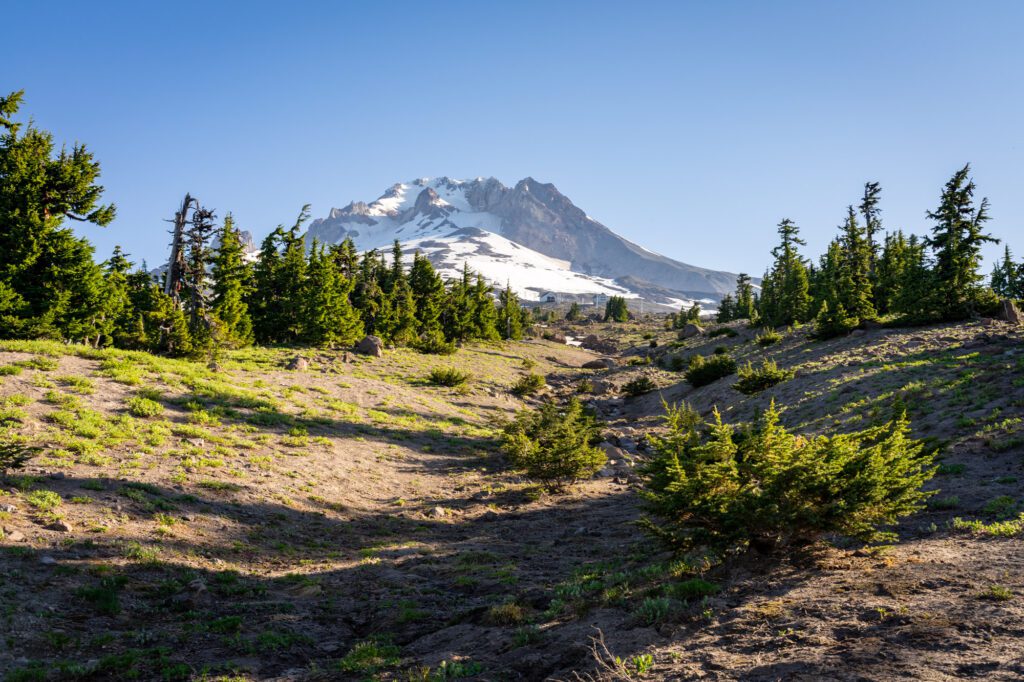
Drive time from Hood River: 45 minutes / 42 miles
Mount Hood is our favorite hiking spot near Portland, and you’ll find us up here every single summer.
In a lot of ways, Portland’s relationship to Mount Hood is similar to Seattle’s to Mount Rainier in that it’s one of the most popular outdoor destinations near the city and it’s a barometer of how nice the weather is (whether or not you can see the mountain).
If you’re coming from Hood River, you’ll be approaching Mount Hood from the eastern side, driving up Highway 35, which skirts the eastern face of Hood. Which puts you in the perfect position to stop and tackle one of our favorite hikes in the state, Tamanawas Falls.
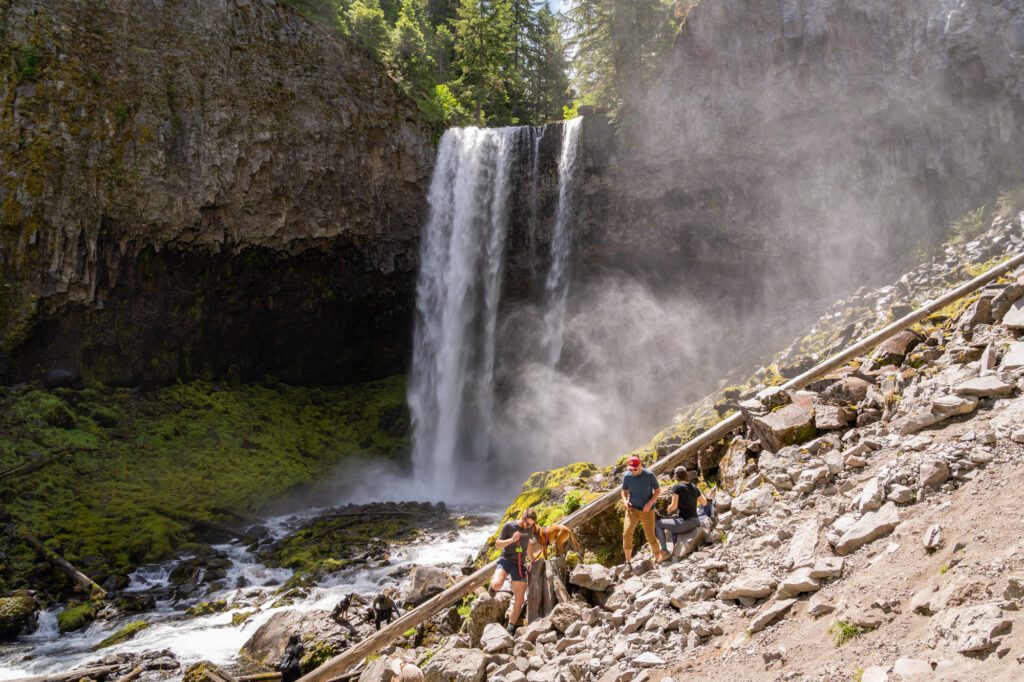
It’s a great waterfall hike, it’s accessible in terms of difficulty, and it’s right off the side of the highway.
The vast majority of the things to do and see at Mount Hood are around the southern side of the mountain, near the town of Government Camp.
It’s a ~15-20 minute detour from your route, and we think it’s worth it if you’re looking for a) some of the best hiking on this entire route and b) one of the most picturesque lakes in the state.
In terms of hiking, you have lots of options near Government Camp.
Our favorite hikes here are Tom, Dick, and Harry Mountain, which climbs to the summit of one of the mountains across the valley from Hood with a magnificent view looking back at the mountain, and the hike to Bald Mountain from Lolo Pass, which ends at another jaw dropping view of Hood.
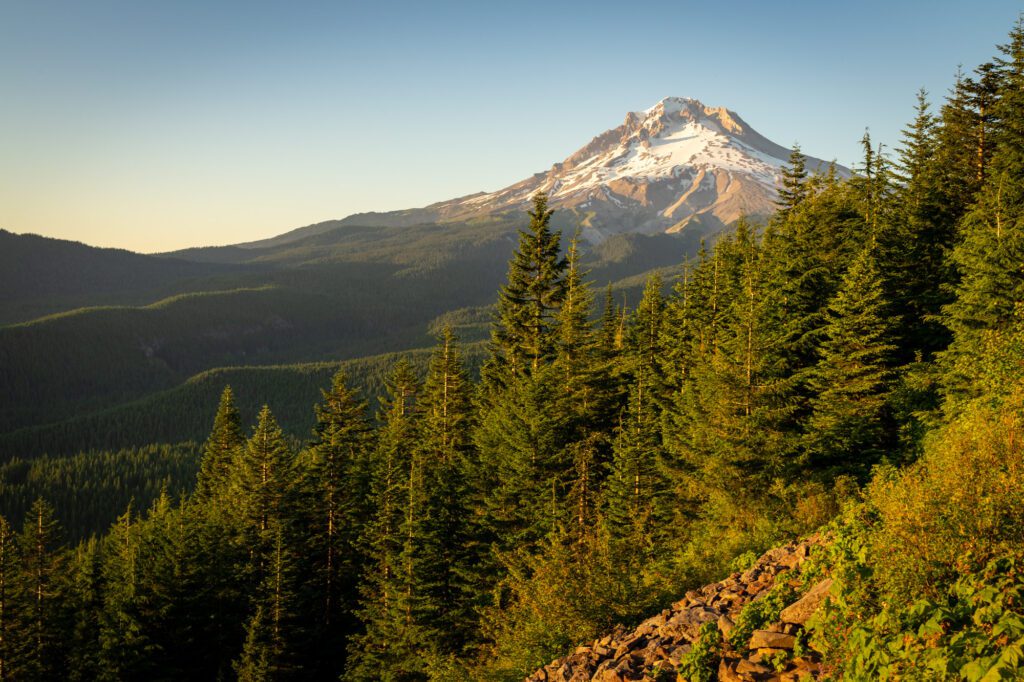
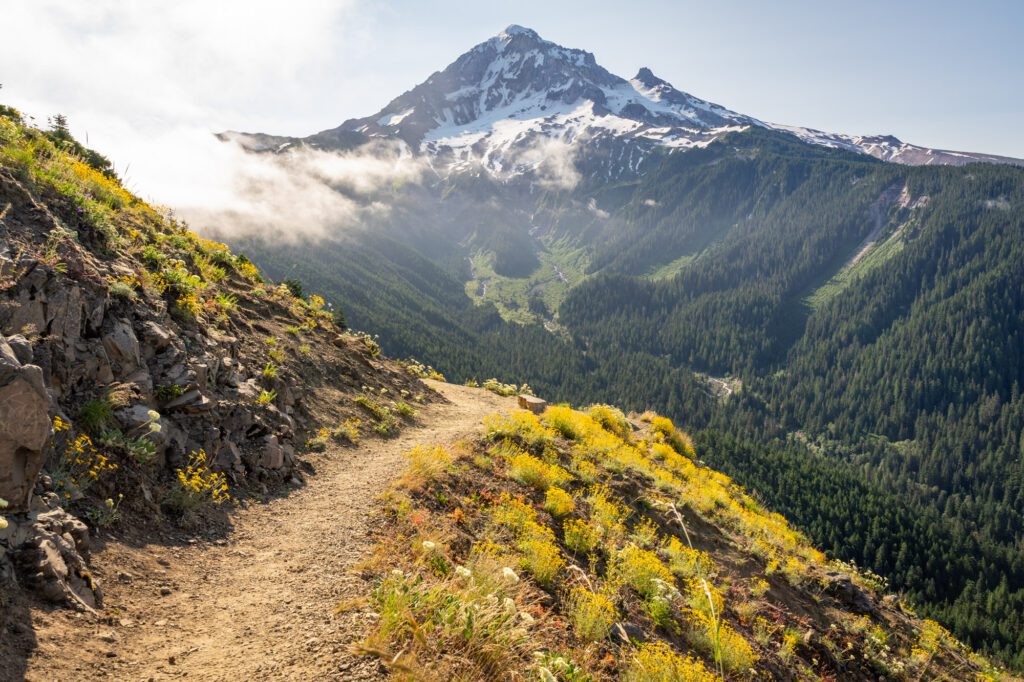
There’s also McNeil Point, which is a brutal climb up to one of the highest points you can reach on foot. That’s a full day excursion though, and it’s probably best for a trip where you have more than a day in the area.
We also really enjoy the majestic and historic Timberline Lodge, which is a century old and feels like a relic from a different time. It’s perched high up on the slopes of Mount Hood’s southern face, and is a great ski destination in the winter, and an equally great hiking destination in the summer and fall.
Timberline Lodge to Zigzag Canyon is a great, relatively easy hike that traverses both ski runs and the Pacific Crest Trail en route to a great view of Hood.
The last place we’d call out here is the aforementioned lake with an unbeatable view, which is called Trillium Lake.
We’ve camped here almost every summer for the past several, and the view from the far end of the lake looking back at Hood is one of our favorites (roughly here on Google Maps).
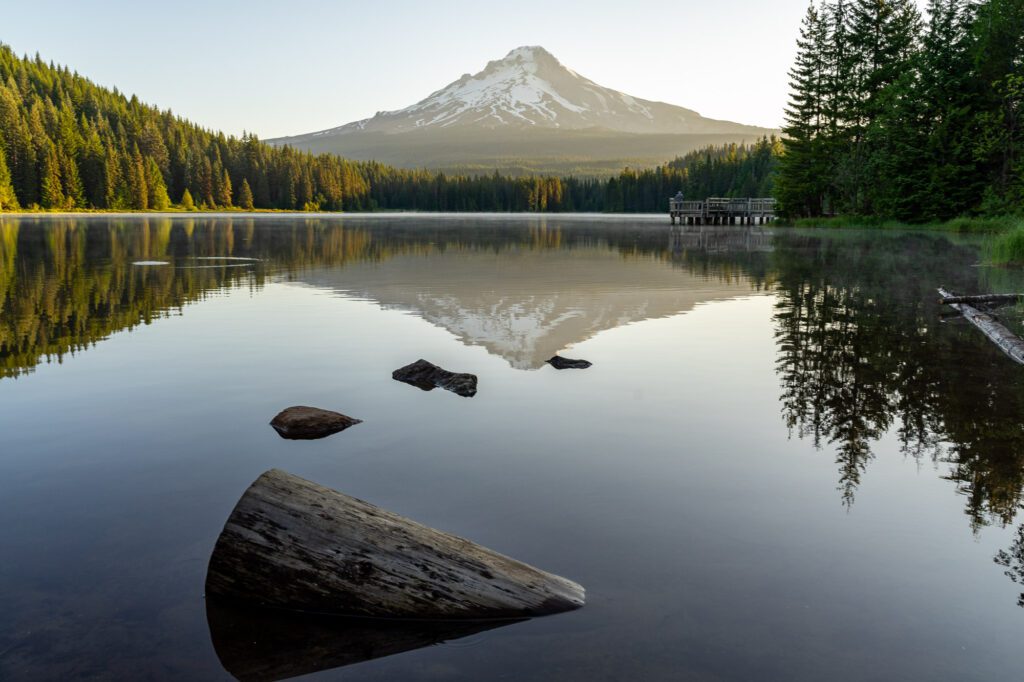
We even have that photo, which we took here at sunrise a few years ago, framed on the wall of our living room in Portland.
If you’re looking for more, head straight to our guide to the best hikes at Mount Hood (we’ve done almost all of them!).
Smith Rock State Park
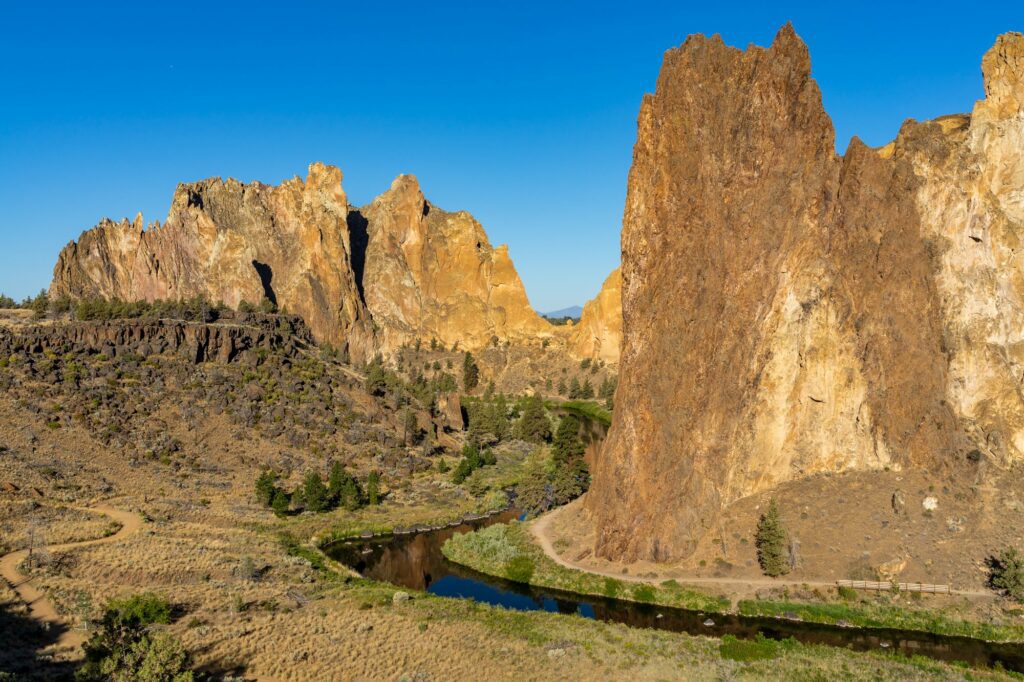
Drive time from Government Camp: 1 hours 45 minutes / 85 miles
Just north of Bend in the town of Terrebonne, you’ll find Smith Rock State Park. We like Smith Rock because, while Bend still feels vaguely like it’s in the mountains, Smith Rock State Park is much more indicative of the types of landscapes you find in central and eastern Oregon. The high desert.
Towering rock formations, dry and dusty, with a dose of rattlesnakes. That’s the high desert for you.
It’s a beautiful park, with a winding river snaking (ha!) its way through deep, rocky canyons.
It also happens to make a great stop between Mount Hood and Bend, which is your next destination as you head south. You only need a few hours to see it, and you can continue north after a jaunt in the high desert.



There’s exactly one thing we think you should do here, and it’s hiking the Misery Ridge Trail.
There are two different versions of this hike, but both of them involve a steep climb to ascend to the ridge, and then a similarly steep descent past Monkey Face – a famous climbing destination that looks like a monkey’s face from a certain angle – where you’ll hit a trail junction.
From that trail junction, a right puts you on the Summit Trail, which is a longer, harder, but more beautiful hike up and around the rim of the canyon.
A left puts you on the River Trail, which is a shorter, easier, mostly flat walk along the river back to the parking lot.
We prefer the longer version, but both are beautiful. It will be hot in the summer, so make sure to bring lots of water and sunscreen with you on your hike.
Bend, Oregon
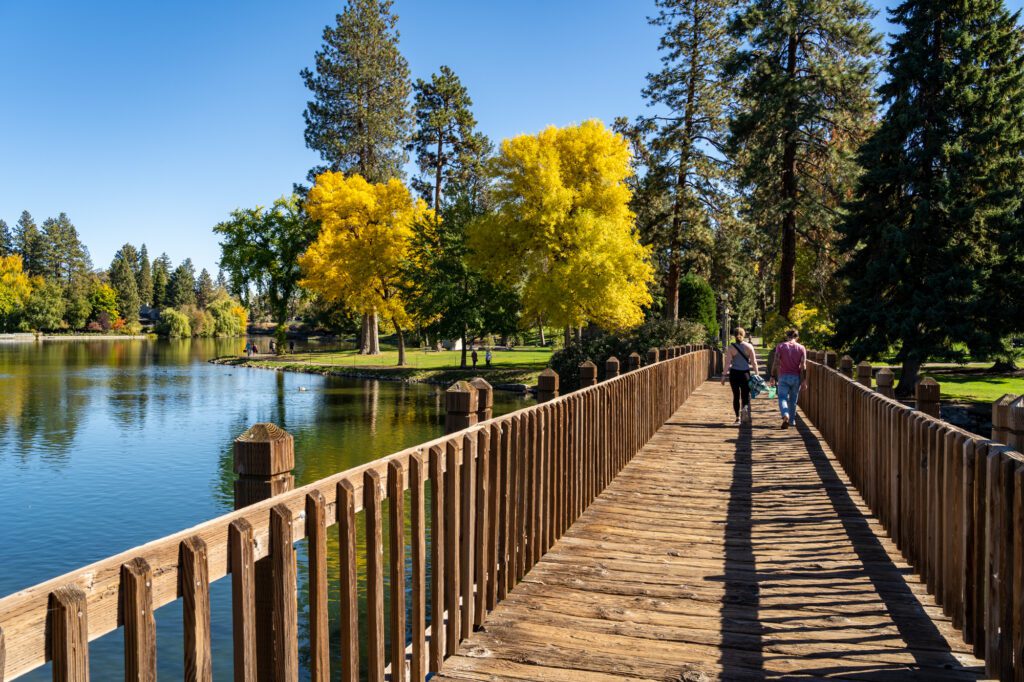
Drive time from Smith Rock: 30 minutes / 26 miles
Bend is one of the best adventure towns on the west coast, if not the entire country. It’s close to the Cascades, and is a veritable hiker’s or skier’s paradise, depending on the season.
However, we’re going to assume you’re here in the summer or fall, which is when this area is at its best (at least in our opinion).
Bend’s location on the eastern slopes of the Cascades put it in a unique position.
It’s close to the mountains, but it’s at the start of the high desert, which is the primary landscape you’ll find in central Oregon, east of the mountains. In every direction, you’re likely to see snow-capped peaks like the Three Sisters, Jefferson, and Bachelor (among others).
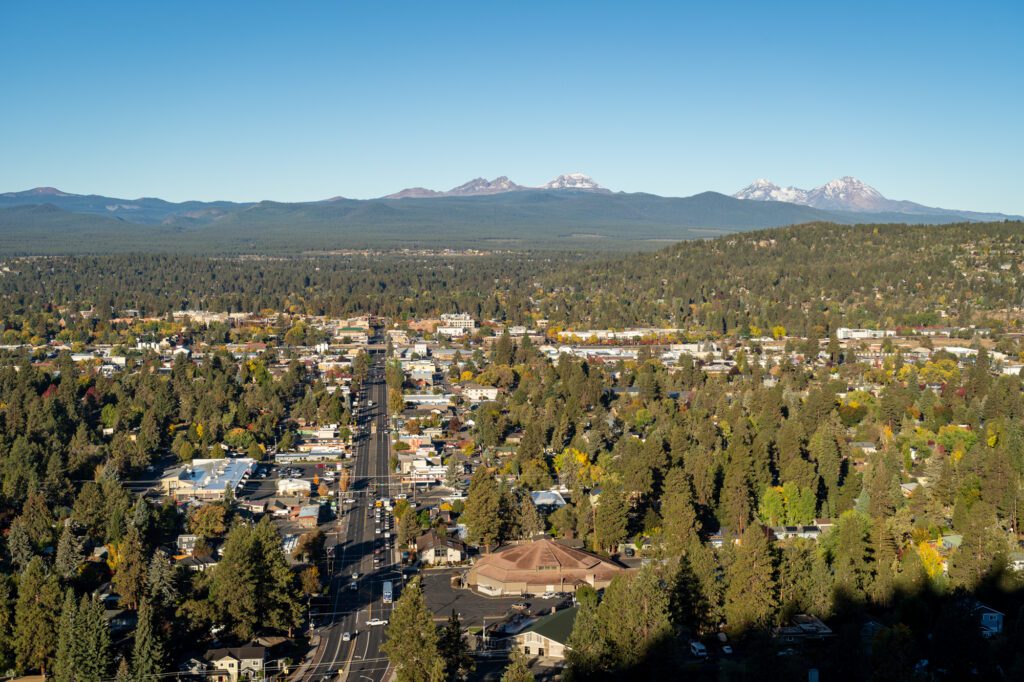
The Deschutes River runs directly through town, creating a playground for lovers of water sports like kayaking and paddleboarding, and Bend’s Downtown and Old Mill District are full of great local restaurants and breweries, the latter of which the town has become famous for over the past decade or two.
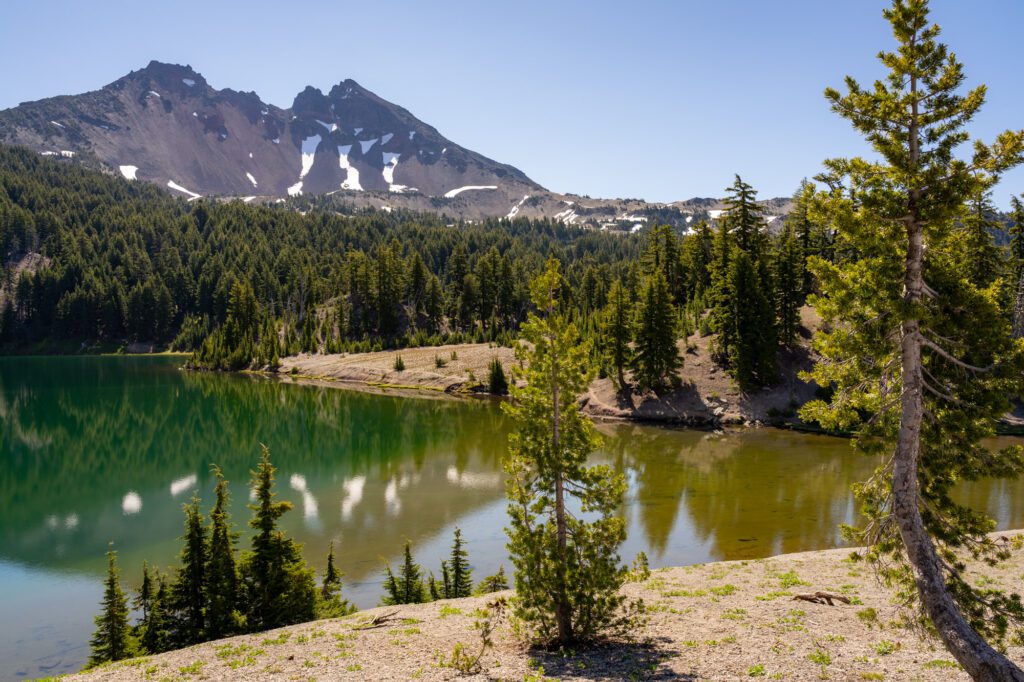
Here are some of our favorite things to do in Bend.
- Hiking: We have a few favorite hikes around Bend. The Green Lakes Trail, which is near Sparks Lake (worth a stop at sunrise or sunset) is an incredible journey following a babbling creek to a trio of three turquoise lakes sitting at the feet of the South Sister and Broken Top, two towering peaks. Tumalo Falls is a relatively easy hike out to a nice waterfall. Right in town, the Pilot Butte Trail takes you up to the top of a small inactive volcano with great views of the surrounding landscape, including a handy guide to all of the mountain peaks dotting the landscape to the west. This hike is a nice, easy walk along the river.
- Floating the river: Escape the summer heat by jumping in the river with a tube and spending the day on a leisurely float. You could also do it via kayak or SUP (stand up paddleboard), depending on what you’re up for. More information here.
- In terms of eating, you’ve got plenty of options in Bend (including just heading to a brewery and ordering their food). Head to the Lot, a food cart pod on the west side of the river, with a bunch of different food trucks and carts for you to choose from. Go to El Sancho Taco Shop for, well, tacos. Spork is good for a fusion of all sorts of different cuisines. Go to the popular Lemon Tree for brunch.
- When it comes to drinking, Bend is known for its breweries. Crux Fermentation Project has a lovely outdoor space, perfect for relaxing in the sun with a pint in the summer. Bend Brewing Co. has a nice outdoor space near Downtown and the river. Silver Moon Brewing has a fun trivia night on Thursday nights that’s worth stopping by.
Crater Lake National Park
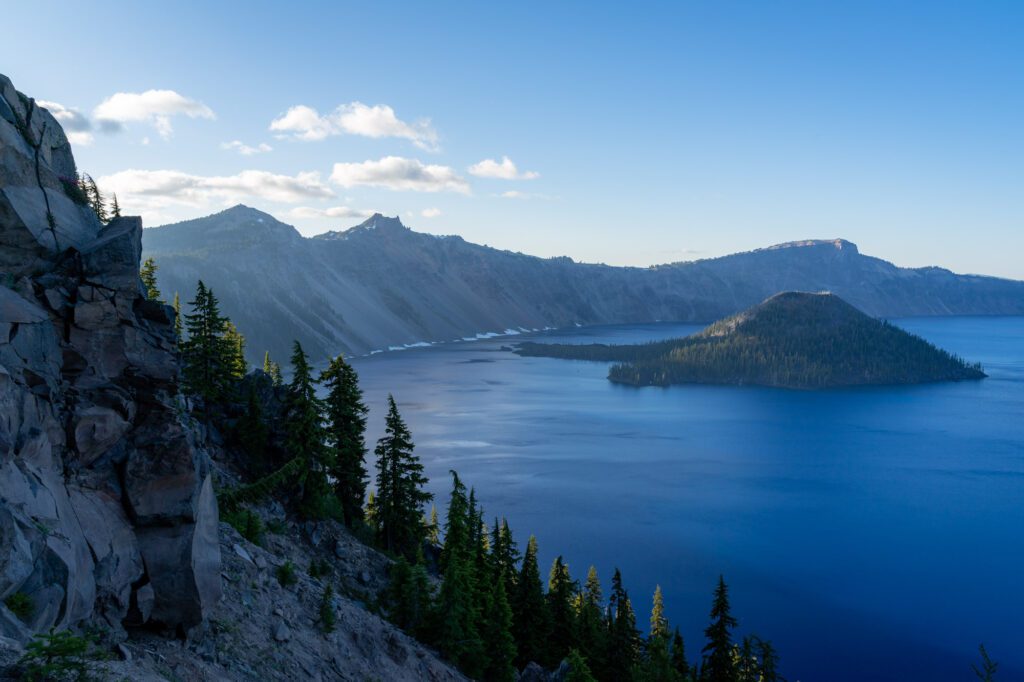
Drive time from Bend to the South Rim: 2 hours / 110 miles
Formed almost 8,000 years ago, Crater Lake is the result of the eruption of Mount Mazama, which used to stand where the crater is today. The eruption caused the volcano to collapse, and here we are.
We think this stop is worth a day or less. It’s beautiful, but there’s really only a couple of things to do in the area, and anything more than a day is probably better spent elsewhere.
Heads up: There are very, very few places to stay near Crater Lake. There are the campgrounds – Mazama Campground is the main one – and there’s the Crater Lake Lodge. Other than that, there’s not a whole lot. Book early!
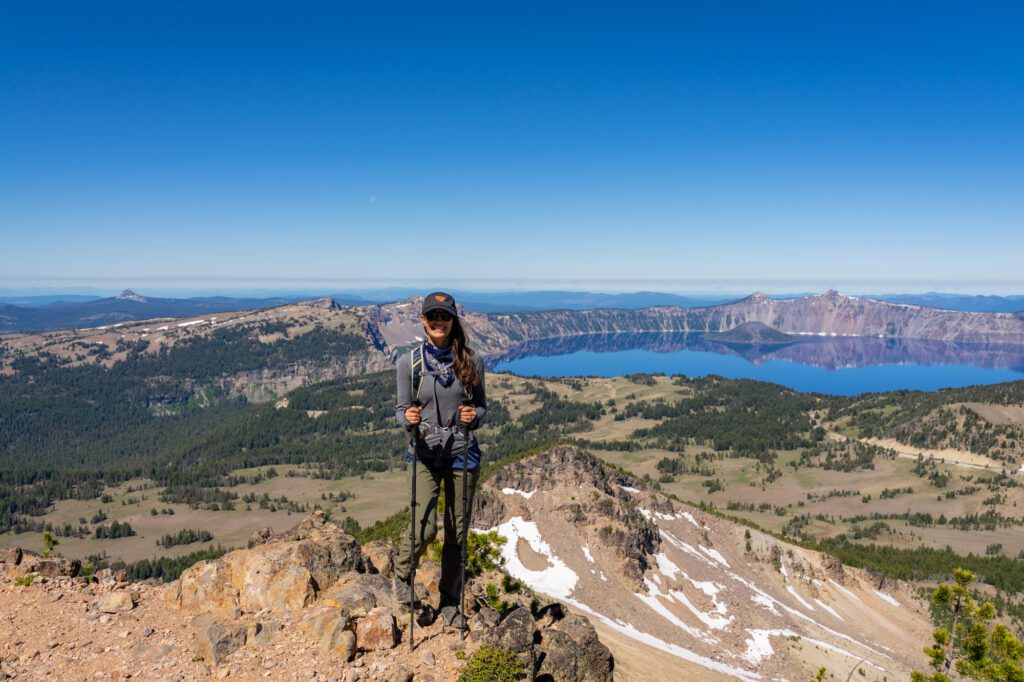
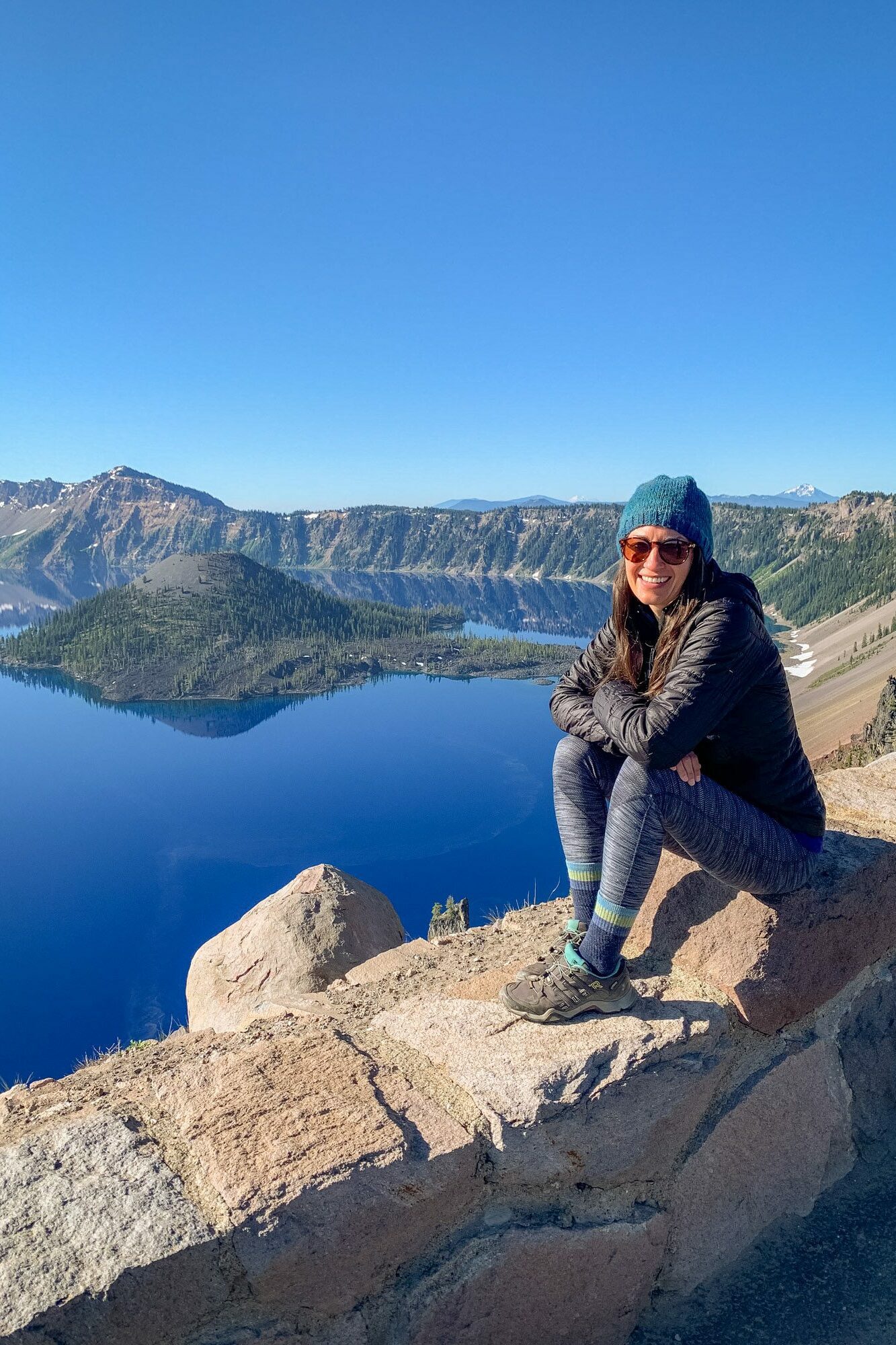
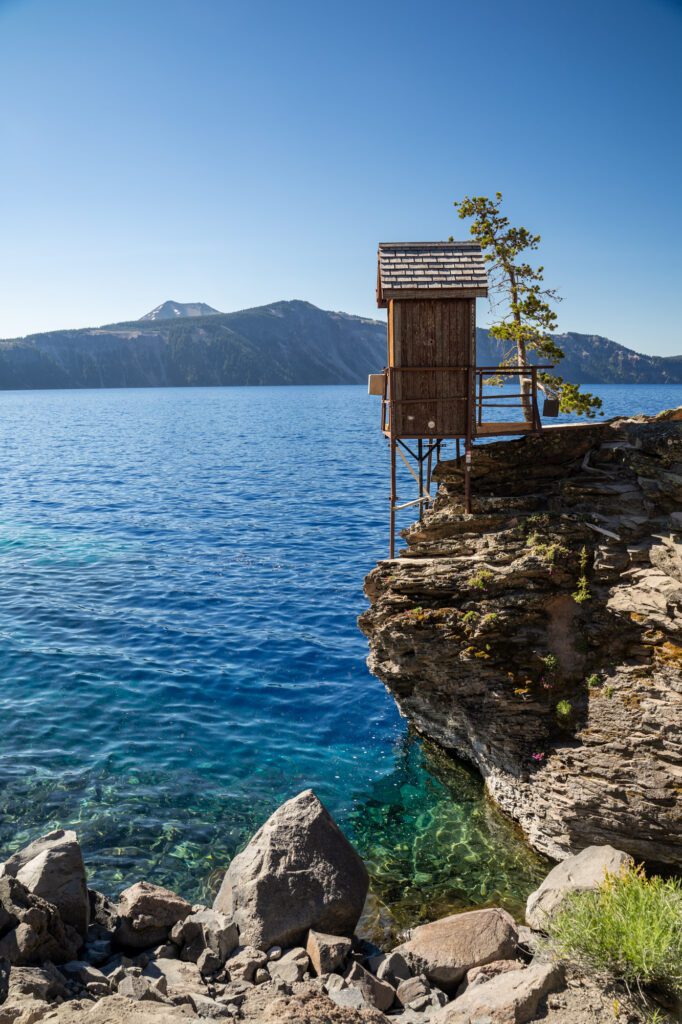
Here are our favorite things to do at Crater Lake.
- Drive the Rim Road: The road around the rim of the lake is 33 miles long, and we think you should make an effort to drive the entire thing, making stops along the way and marveling at the sapphire blue water of the lake from all sorts of different angles. The drive is best before 9:00 am, when the traffic on the road starts to build and it becomes a whole lot harder to find parking at the various pullouts. The road around the eastern edge of the lake opens in the summer and closes during the fall – check road conditions here.
- Hike to the highest and lowest points in the park: There are a couple of hikes we think are worth doing at Crater Lake. Mount Scott takes you to the highest point in the park for fantastic views of the lake and surrounding area. Cleetwood Cove is the only place in the park where you can get down to the water level. Both are fantastic.
- Watch the sunset from the rim: Close out your day by watching the sun set from the rim. We have spent sunsets at Cloudcap Viewpoint (here on Google Maps), which is on the east side of the lake facing the setting sun. Get there an hour before sunset for a prime parking spot. The other spot to go for sunset is Garfield Peak, which involves a steep 3.4 mile hike to a viewpoint with a great view of the lake and the setting sun.
Redwood National and State Parks
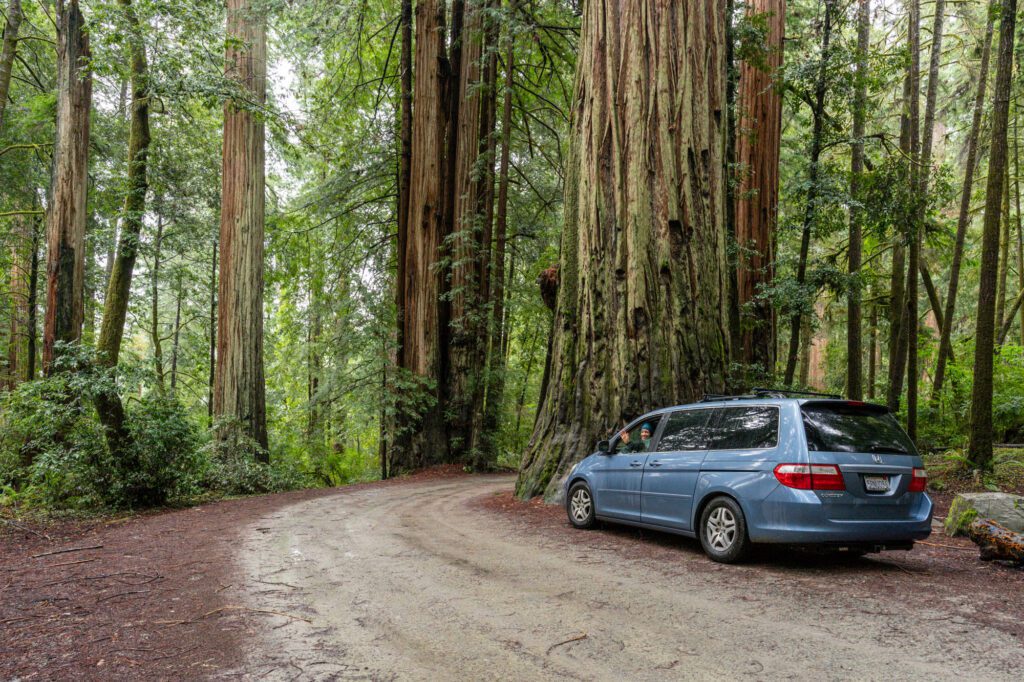
Drive time from Crater Lake’s South Rim: 5 hours / 230 miles
And finally, you’ve made it to California!
Getting to the coast from Crater Lake involves a long drive, but it’s worth it. You’ll head west form Crater Lake to get back to I-5, then continue on towards the coast on Highway 199, which leaves from Grants Pass and meets up with 101 near Crescent City, California.
Your next destination is a complex of national and state parks – Redwood National and State Parks – which, collectively, are the best place in the world to see towering coastal redwoods.
What exactly is included in this complex of parks, you ask? It includes Redwood National Park and three California State Parks – Del Norte Coast, Jedediah Smith, and Prairie Creek – forming a complex that is prime redwood territory. The complex was protected under the National Park Service through activism by the Save the Redwoods League, who fought to preserve the best example of coastal redwoods in the state against the desire of logging companies
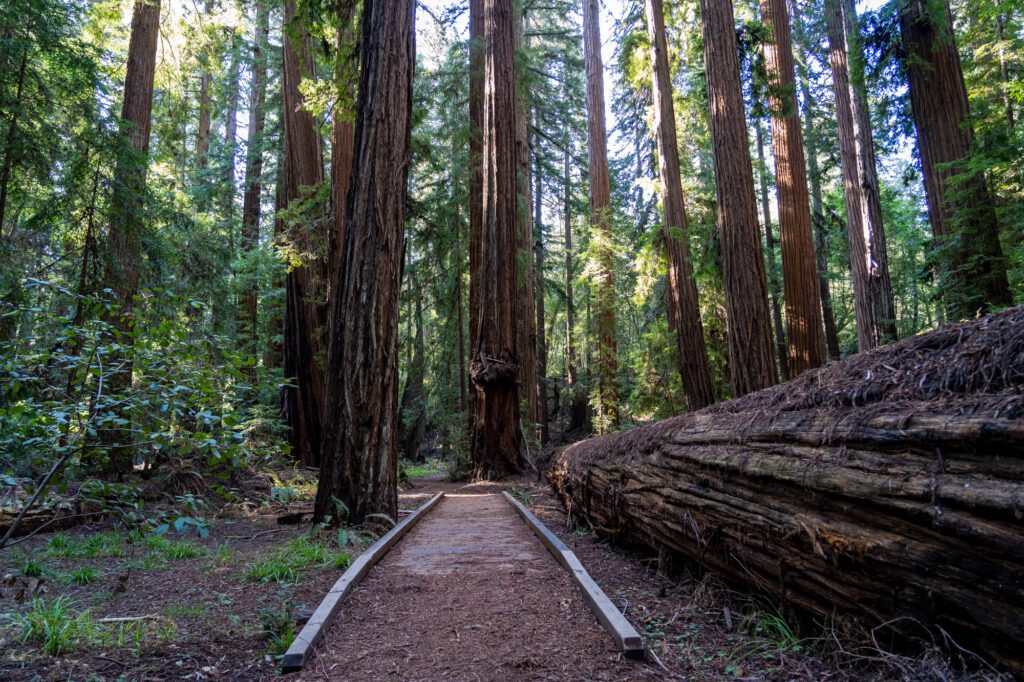
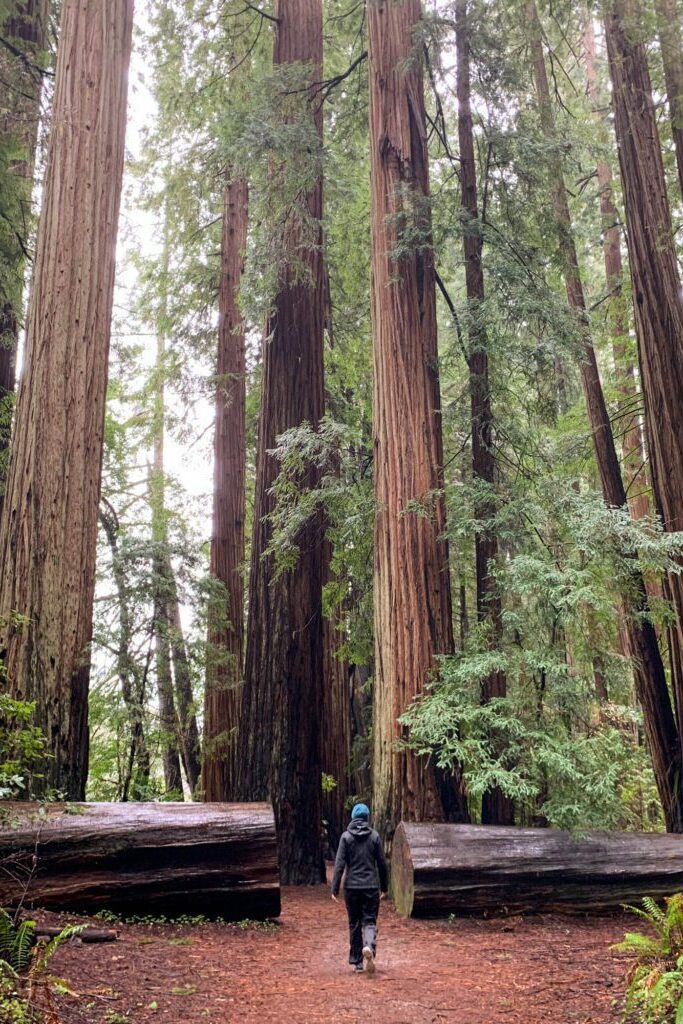
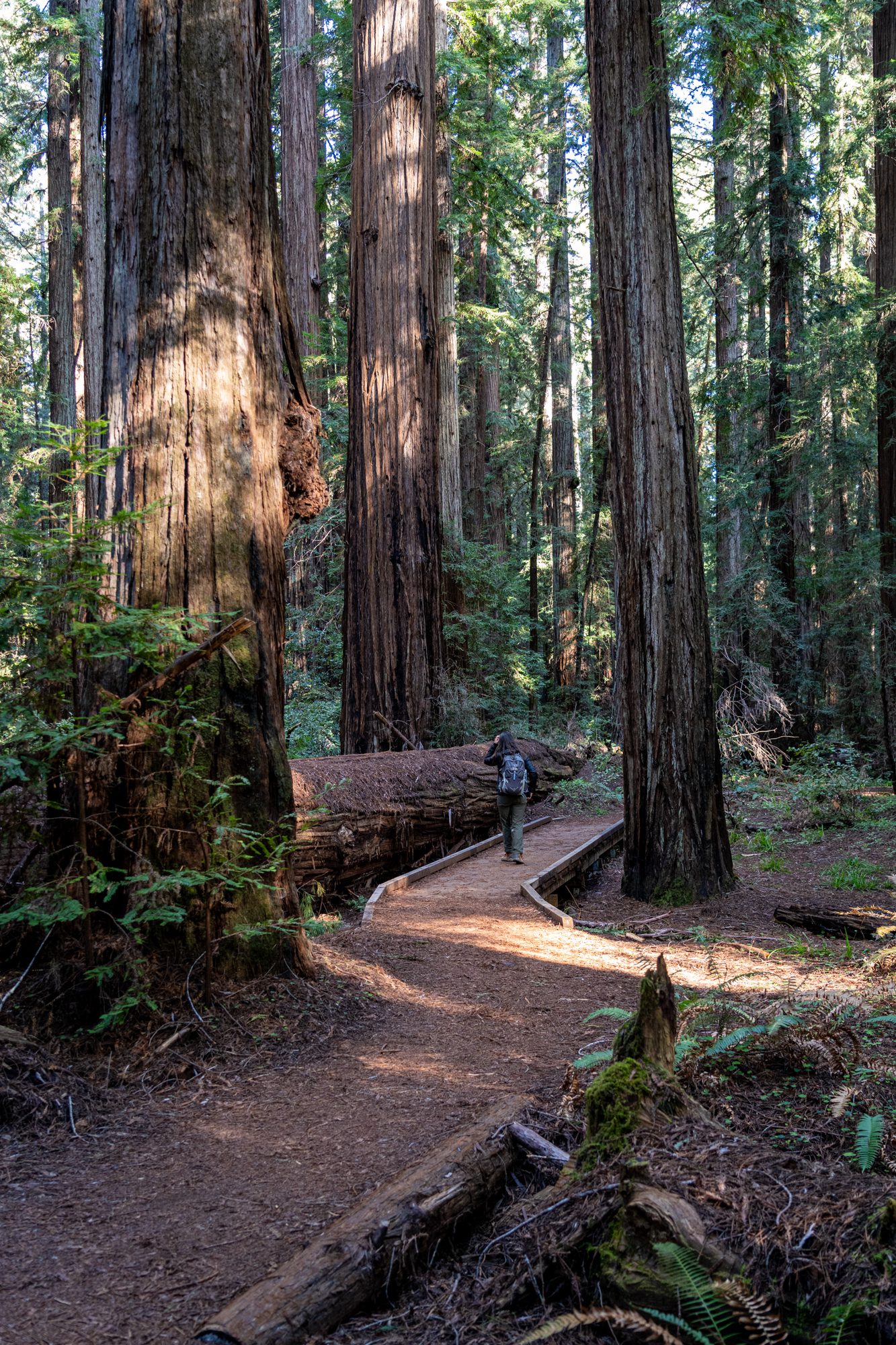
- Howland Hill Road: Drive through the redwoods – and we really mean that – along this 10 mile long stretch that used to be a stagecoach road. It’s narrow, but it’s about as up-close-and-personal as you can get to the redwoods. We drove it in our minivan in the winter, and it wasn’t bad at all – should be suitable for most (if not all) vehicles. More information here.
- Stout Memorial Grove: A short, beautiful hike featuring huge redwoods that were used in various movies, from Return of the Jedi (keep an eye out for Ewoks!) to Jurassic Park. The size of some of these trees – particularly the downed trees – is staggering. More information here.
- Fern Canyon: The most famous hike in this part of the state, this hike starts at a trailhead that is hard to access in the wetter months, as rain can wash out the road. If you’re doing this in the winter, you probably need a high-clearance vehicle. The hike itself enters a canyon that is, you guessed it, full of ferns. Like, ferns lining the walls of the canyon top to bottom. It’s surreal, and feels like it should be in a Jurassic Park movie. Can’t access the trailhead because of the washed out road? Here’s an alternate route that takes you into the canyon from the end of the well-maintained road.
- Newton B. Drury Scenic Parkway: Similar to Avenue of the Giants, this scenic drive takes you parallel to 101 through Prairie Creek State Park and a nice string of redwoods.
Avenue of the Giants
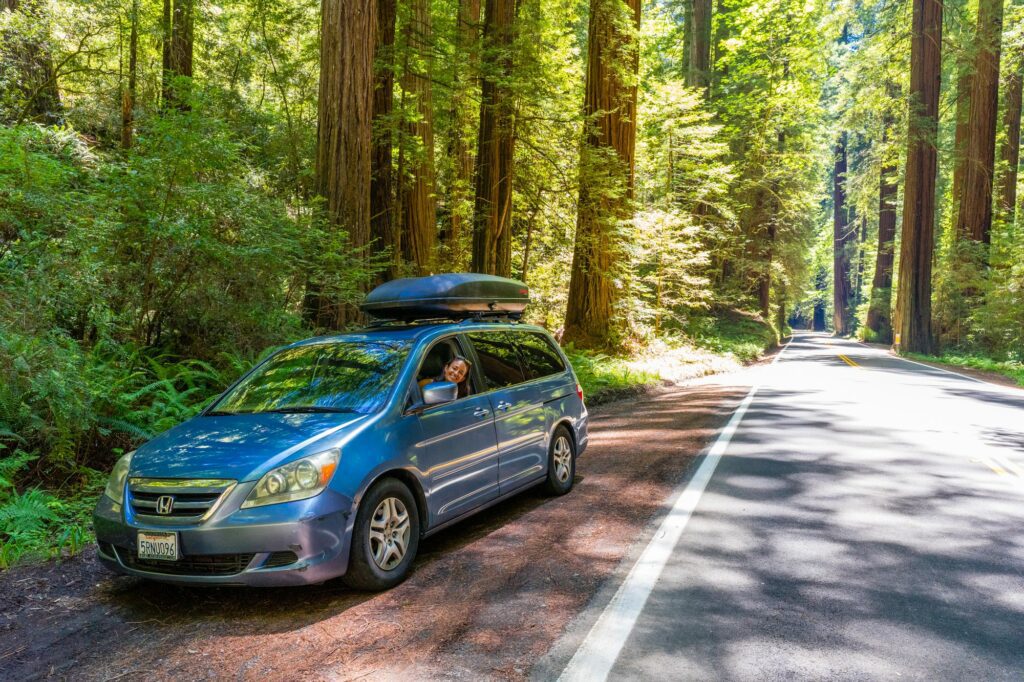
Drive time from Trinidad: 1 hours 20 minutes / 70 miles
While the Avenue of the Giants is basically parallel to 101, the main highway you’ve been driving on, it is truly a whole different world.
You’ll meander along a windy, two lane road through massive redwoods for 31 gorgeous miles. It starts here, and there are countless points to pull over and walk into the redwoods that are often thousands of years old, marveling at their size.
For what it’s worth, we loved the Bull Creek Westside Loop, which is a three mile hike through the redwoods, with enough up and down to get the blood pumping after a long drive.
Mendocino
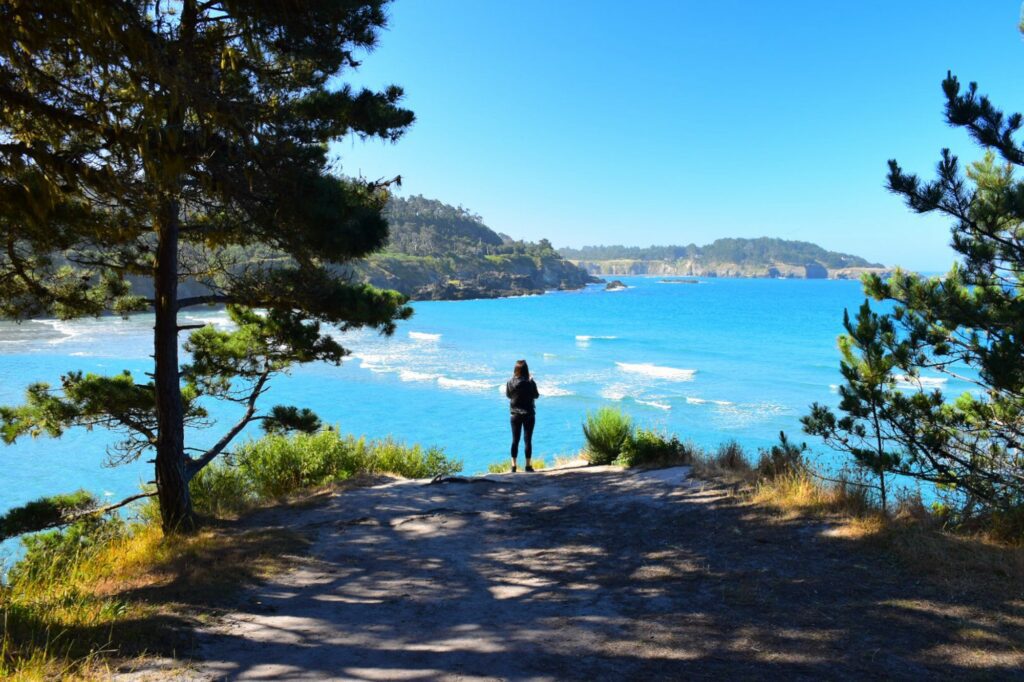
Drive time from the Avenue of the Giants: 2 hours 30 minutes / 100 miles
This is a long drive, but it’s not like there aren’t stops to make along the way. This is the part of the journey south where you meet up with world-famous Highway 1 (don’t let Google Maps tell you to cut inland, which is slightly faster and far less scenic) south along the Northern California coast towards San Francisco.
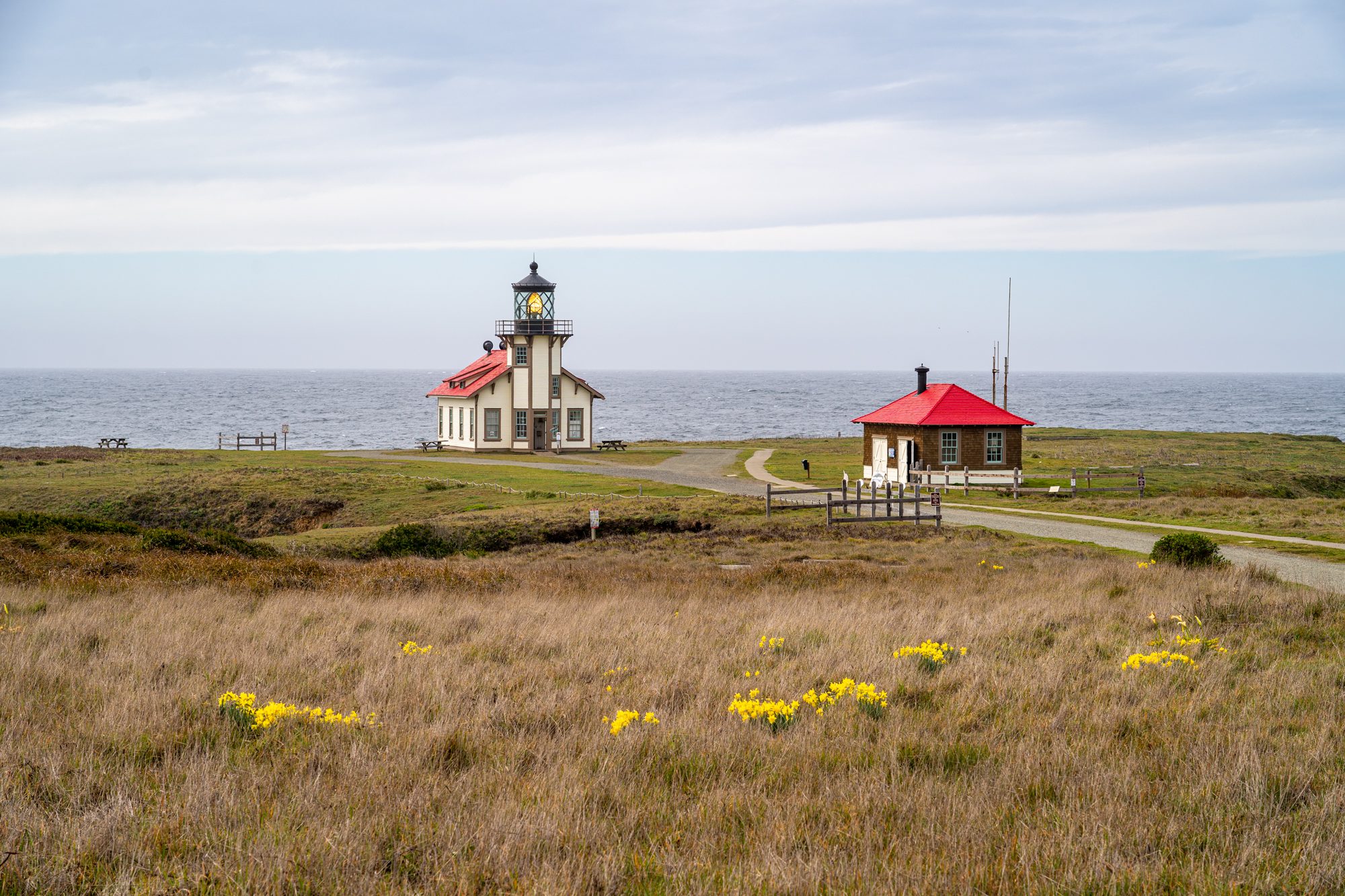
Make your way down the coast to Mendocino, a lovely little town on the Northern California coast, perched on a bluff over the Pacific Ocean.
We’re going to include Fort Bragg in this section too, which is a small town just a few minutes north of Mendocino.
Here are some of our favorite things to do on this stretch of beautiful California coast.
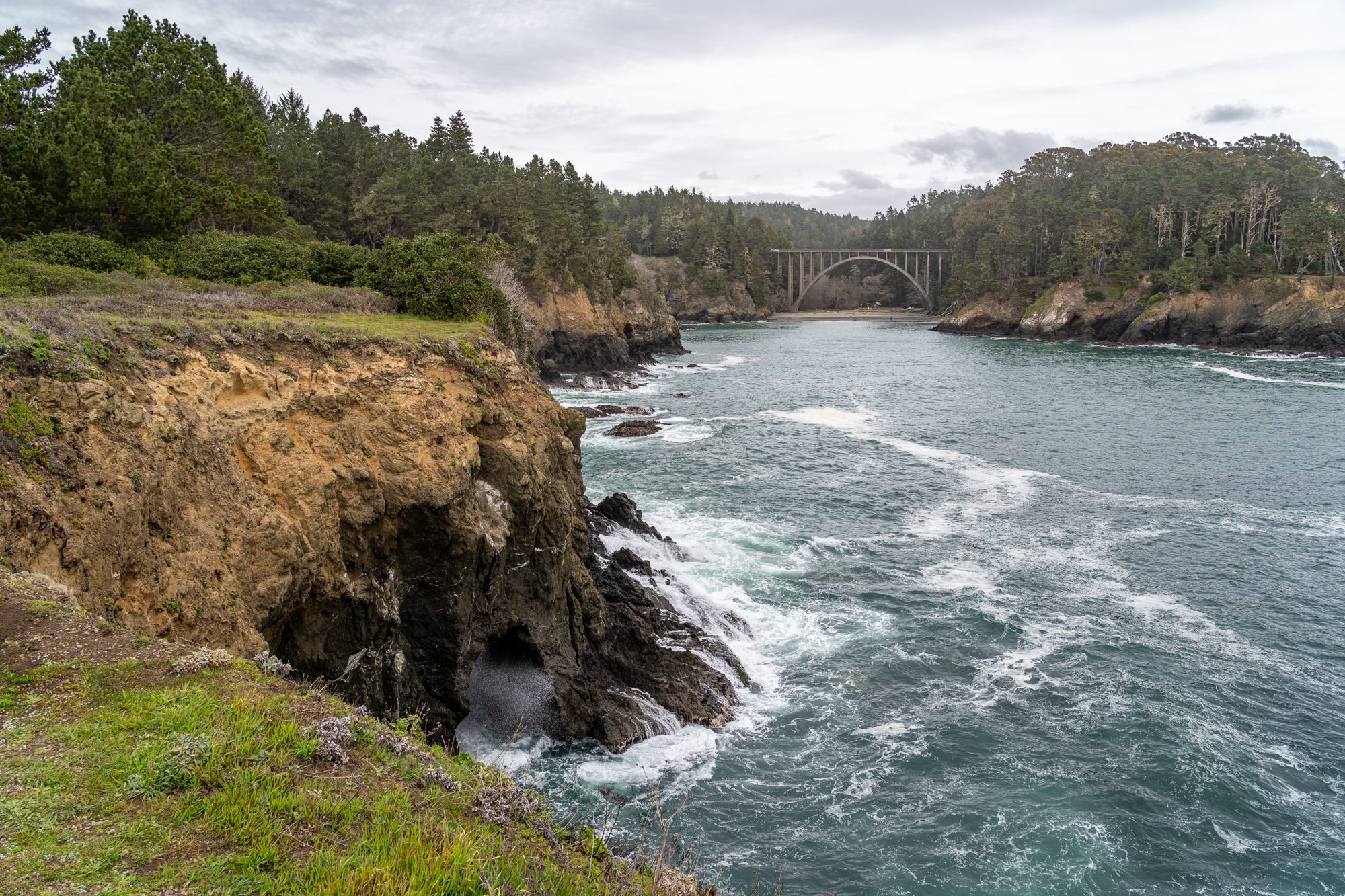
- Hike the Point Mendocino Trail: The Point Mendocino Trail takes you out onto the bluffs where Big River (creative name) meets Mendocino Bay and, ultimately, the Pacific Ocean. The short, easy hike makes a loop along the bluffs on the southwest side of town, and is a perfect location for a morning stroll. Afterwards, grab breakfast in town at the Good Life Cafe and Bakery or Cafe Beaujolais.
- Explore Russian Gulch State Park: This sliver of land that comes inland from the coast is a gorgeous setting for an afternoon stroll in the woods. Do this lollipop hike starting from the western entrance, making your way up the canyon, and doing the waterfall loop at the eastern end of the park. There’s also a shorter loop that focuses on the area around the waterfall. Fern Canyon is another good redwood hike, just south of Mendocino.
- Go wine tasting in the Anderson Valley: Alysha took me to Mendocino for my birthday a few years ago, and one of our favorite things we did was wine tasting in the Anderson Valley, which is ~40 minutes inland from Mendocino. In a part of the country known for amazing wine, we’re used to having to fork over at least $20 for three tiny pours of wine, which we inevitably split to save money. Not so in the Anderson Valley! It’s more affordable, and the wines are a better fit for our palates (we prefer light and fruity reds and whites to big and bold, which is what Napa is known for). We loved Roederer Estate for bubbles, and Navarro for the setting (and their Gewurztraminer is great, too). Hendy Woods State Park is worth a stop out there too, for the redwoods.
- Explore Glass Beach and Point Cabrillo: These are both quick stops north of Mendocino towards Fort Bragg. Point Cabrillo is home to a nice lighthouse and some coastal hiking trails. Glass Beach is a cool beach made of sea glass rather than sand (here on Google Maps).
Point Reyes National Seashore
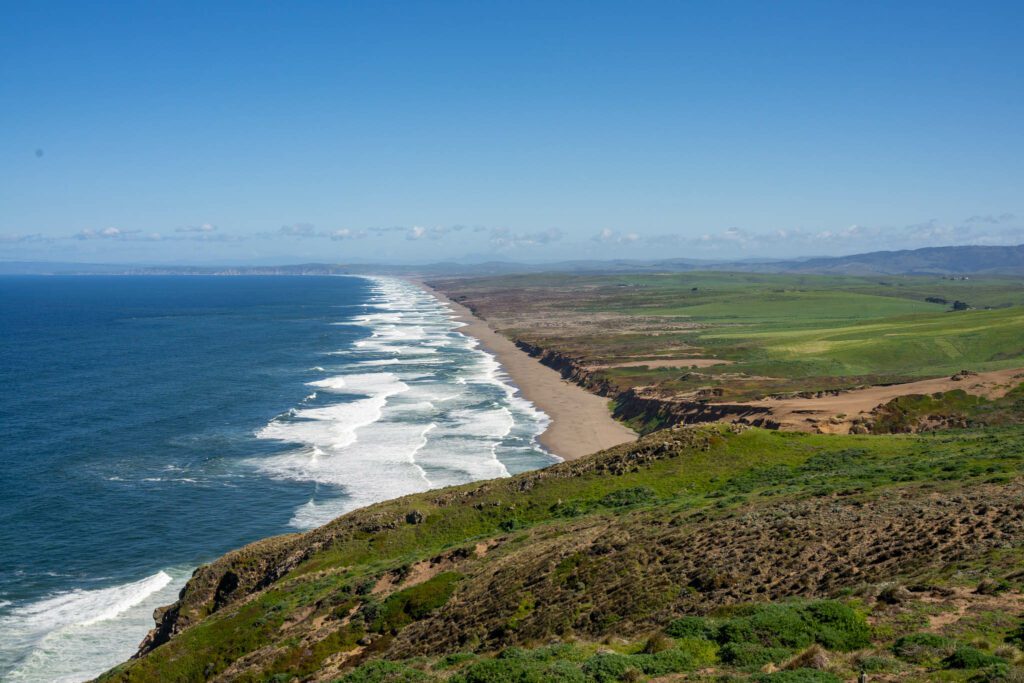
Drive time from Mendocino: 2 hours 45 minutes / 135 miles
Today is a long driving day, with three and a half hours (and 140 miles) of sheer coastal California beauty waiting for you between Mendocino and Point Reyes.
There are plenty of places to get out and stretch your legs along the way. However, with limited time, we would recommend just a stop rather than spending an entire day or night here – you’ve got a long way to go!
Some good stops to make are the charming seaside town of Bodega Bay, Wright’s Beach and Sonoma Coast State Park, and Jenner Beach, to name a few.
Point Reyes is a big peninsula that juts out into the Pacific, separated from mainland California by Tomales Bay. There are two main places to explore here – on the peninsula, and in the town of Point Reyes.
You should know that the drive time / distance above gets you to the town of Point Reyes Station, which is a charming small town that’s definitely worth a stop, but the real fun starts after another 45 minute drive out to the coast.
That drive is full of rolling hills, pastoral scenes featuring barns and cows, and coastal views as you approach your destination.
We’re biased, because Alysha grew up about 30 minutes away from here, but we think this is going to be among the most stunning places you visit in Northern California.
From December to May, this is prime whale watching territory. We’ve seen migrating gray whales frolicking in the shallow waters just below the Point Reyes Lighthouse before.



Here are some things to do in and around Point Reyes.
- Visit the Point Reyes Lighthouse: A gorgeous lighthouse set into a cliff, accessed via a steep set of stairs. This is one of our favorite lighthouses in California, and probably on the west coast. It’s a long drive to get there, but we think it’s worth it. More information here.
- Hike the Tomales Point Trail to see some Elk: The Tomales Point Trail is an excellent hike for stunning coastal views and, surprisingly to some, elk. There’s a relatively big Tule elk population that calls the peninsula home, and this hike is one of the best places to see them. The last time we did this trail, we came across numerous elk along the trail, including a cute mama and baby elk that were just hanging out, grazing with a view. It’s a long hike out to the northern tip of the peninsula, but you can do a portion of the trail to get a feel for the landscape and wildlife.
- Explore Point Reyes Station: Point Reyes Station is a cute little town with a surprisingly high number of good places to eat and drink. The two best are easily Cowgirl Creamery, a famous cheesemaker that is an excellent place to grab lunch and cheese, and Bovine Bakery, who makes Alysha’s favorite Bear Claw (among other pastries).
- Eat oysters on Tomales Bay: Tomales Bay is famous for its oysters, and you can enjoy them fresh at various places along the shores of the bay. Hog Island Oyster Co. is the most famous, and is our pick. They have an oyster bar about half way up Tomales Bay from Point Reyes Station (here on Google Maps).
- See the Cypress Tree Tunnel: You’ve likely seen pictures of the famous Cypress Tree Tunnel from your favorite photographers on Instagram. The trees have grown over the road in a nice little canopy, and the light is particularly nice at sunrise and sunset, when the low angle of the sun means that the golden glow enters the canopy. It’s on the way to the Lighthouse, and makes for a nice stop – here on Google Maps.
Mount Tamalpais & Around
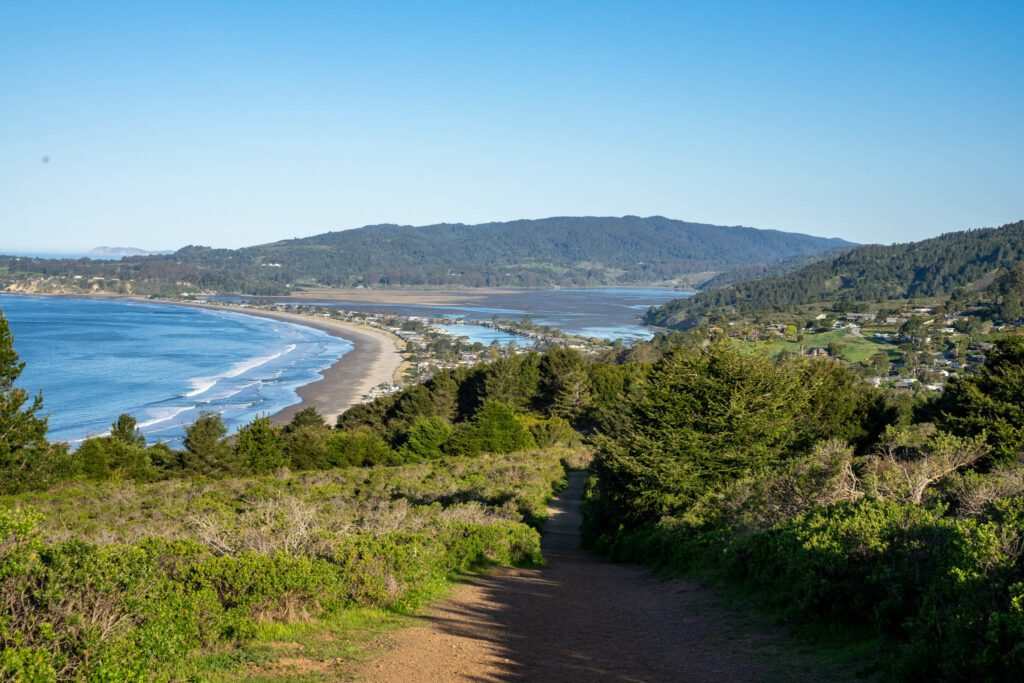
Drive time from Point Reyes to the Mountain Home Inn: 45 minutes / 24 miles
If you thought you were going to be able to get to San Francisco without making several stops on your way into the city, you were mistaken.
Since we lived in San Francisco for nearly a decade, there are a bunch of places just outside the city that we have visited over and over again.
This is one of those places that we love, and this stop is for hiking enthusiasts.
A couple of the best hikes in the Bay Area are found in the area surrounding Mount Tam, and we’re going to give you three of our favorites.
- The Dispea, Steep Ravine, and Matt Davis Loop: This might be our favorite hike in all of northern California. It has it all – redwoods, babbling brooks, and coastal views. Start from the parking area near Stinson Beach (here on Google Maps) and head downhill first before climbing back up. The scenery changes drastically over the course of the hike, which makes it fun and interesting.
- Cataract Falls: A moderate hike to a cascading waterfall, be aware that you’re hiking downhill on the way there, which means you’re going to be hiking uphill the entire way back.
- Mountain Home Inn to East Peak: This is a hike we’ve done numerous times. Sure, you can totally drive to the parking lot at the East Peak, but where’s the fun in that? The views are always better when you earn them, and this hike through the woods is the way to do just that. From the top of Mount Tam’s East Peak, you can see the entirety of the Bay Area, sprawling out before you.
Muir Woods
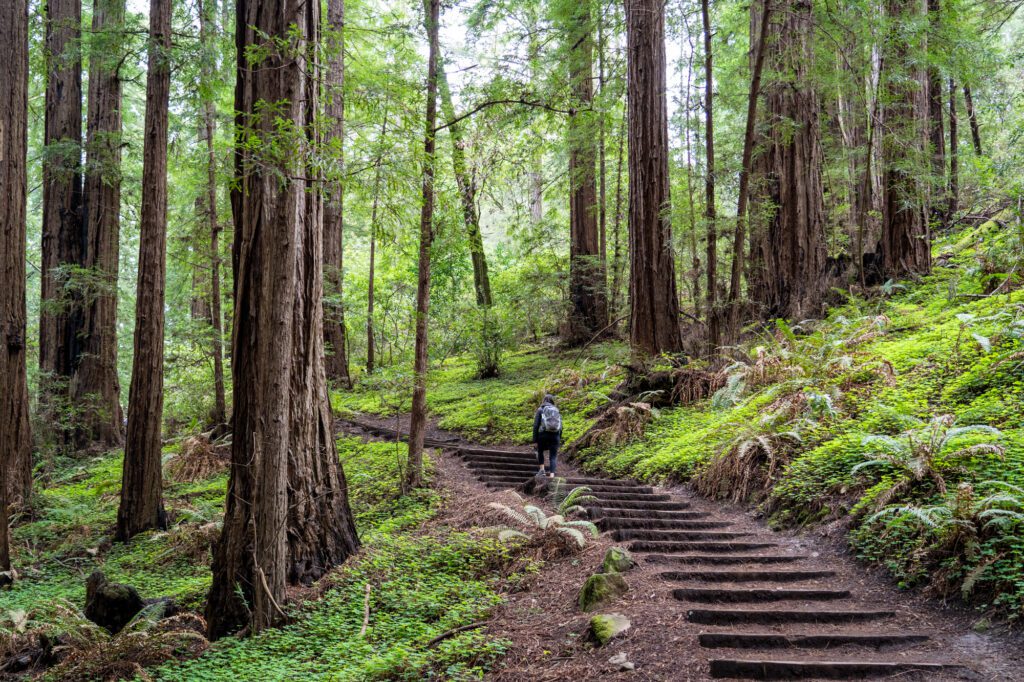
Drive time from Mount Tam: 10 minutes / 3 miles
We went back and forth on whether or not to include Muir Woods on this itinerary at all.
Why? Because – SPOILER ALERT – you have already seen some pretty incredible redwoods on the Northern California coast, and we think they’re much more impressive than the ones you’ll find at Muir Woods.
But, we decided to give you the information so you can make that decision for yourself.
Muir Woods is a National Monument, and it was created to protect 240 acres of old growth redwoods, which used to be commonplace in the Bay Area but are, sadly, now relegated to just this little slice of paradise thanks to the logging industry. Most of the trees here are somewhere between 500 and 800 years old.
There are two ways to access Muir Woods.
First is navigating the permit system, which is how they limit the number of people within the area.
You’ll need to either make a parking reservation in advance (which allows you to park right at Muir Woods, which has a small parking lot) OR make a shuttle reservation in advance, where you can park at a large parking lot and take a quick and easy shuttle to and from the park.
The shuttle is only available on weekends and holidays, but parking is much easier to get on weekdays so it shouldn’t be a problem if you plan in advance.
More information on the permit system here.
The second way to access Muir Woods is less known, and it involves some (beautiful) hiking. This short hike from the Mountain Home Inn is the back door to Muir Woods.
You’ll start from atop the Panoramic Highway (which is a fun drive in its own right) and drop down into the forest, winding your way towards Muir Woods from the backside.
Whichever direction you do it, you’ll have a relatively steep uphill section to get back to your car. Make sure to get to the parking lot very, very early (especially on a weekend) because it’s tiny. There is some parking along the highway, but it also fills up by 10:00 am or so.
The Marin Headlands
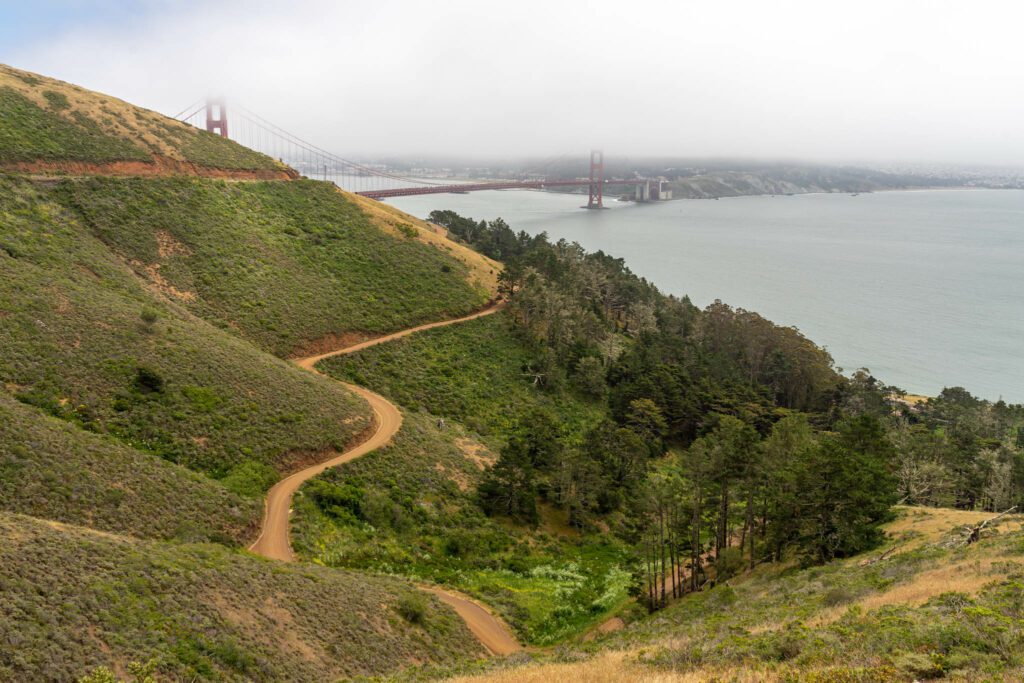
Drive time from Muir Woods: 30 minutes / 15 miles
Your trip to San Francisco ends with a drive across the world-famous Golden Gate Bridge. It’s worth parking at the toll plaza (here on Google Maps) to get some nice pictures of the bridge. If there’s no coastal fog obscuring it, which there probably is.
Right before you drive across the Golden Gate Bridge, you’ll come across the towering coastal bluffs on the northwest side of the bridge.
These are the Marin Headlands, and there are a bunch of amazing hikes and things to do and see here.
- Kirby Cove: A nice protected cove just north of the Golden Gate, there’s a short hike downhill to get to a sandy beach with an unbeatable view of the bridge. You can actually camp down on the beach, but reservations need to be made six months in advance, to the day.
- Battery Spencer: One of the best views of the Golden Gate Bridge, it’s on the northwest side, where parking is notoriously hard to find. Consider walking to Battery Spencer after you hike to Kirby Cove without moving your car (they’re a few hundred feet apart).
- Point Bonita Lighthouse: A short hike takes you to a lighthouse that was built in 1855 to help ships navigate the treacherous waters around the Golden Gate, which refers not to the bridge, but to the opening into the bay. It’s a short hike (uphill on the way back), and when you arrive at the lighthouse you cross a fun little suspension bridge. More information here.
- Rodeo Beach: A nice, wide sandy beach just north of the Golden Gate. Perfect for a nice picnic lunch before a hike.
- Hiking: There are multiple hikes in this area, but we have two favorites. First is the Rodeo Beach / Coastal / Miwok Trail, which takes you from Rodeo Beach along the coast and up and over the hill with stunning views all the way through. The second, which is a little further north, is the Tennessee Valley Trail, which is an easy hike that takes you out to a beautiful, secluded beach (extend it by hiking to Muir Beach, another gorgeous beach).

Hi, first of all thank you so so much for this amazing post. We’re going to California in mid October, and thought since we’re already flying in from outside US, maybe we should do our long wished-for seattle-SF trip. However a bit unsure about the timing, how is it in mid October there? What’s the weather like and is there any concerns doing it that late? (we’re probably gonna do a 10-14 day trip).
Thank you again.
/Pontus
Hey Pontus! So sorry for the late reply – I totally missed this. Hopefully you’ve found the answer you needed elsewhere, but for anyone else wondering what the weather is going to be like in mid-October, you’re likely going to get some great fall color, though the weather could be more unpredictable, with rain or even snow. It totally depends on the year. Still, totally doable in October. Early November is when the weather really starts to turn.
Hey Matt,
Came across this article and this looks amazing.
I was planning a similar trip and I think I’m just going to follow your itinerary to a T!
I did have a concern though, I’m likely doing 2 weeks from October 28th to Nov 11th 2022. How’s the weather like for a Road Trip and visiting alot of these spots then? Would it be too cold in Washington/Oregon?
Thanks in advance!
Hey Roy!
As you get into November, it’s going to get more unpredictable. You might end up with more rain and snow, which isn’t necessarily a deal breaker if you’re prepared for it (pack a good rain jacket and waterproof shoes / boots!).
I’d start in Washington and move south in hopes that you get the last pieces of good weather in the Northwest, but it’s hard to say what you’re going to get at that time of year.
Cheers!
Matt
Oh! And roads at Mount Rainier NP close sometime in early November, which is another reason to start in Washington if you’re planning on going to Rainier.